Black Raptor/JimnyBits 2″ Lift Kit Install
How it compares to standard
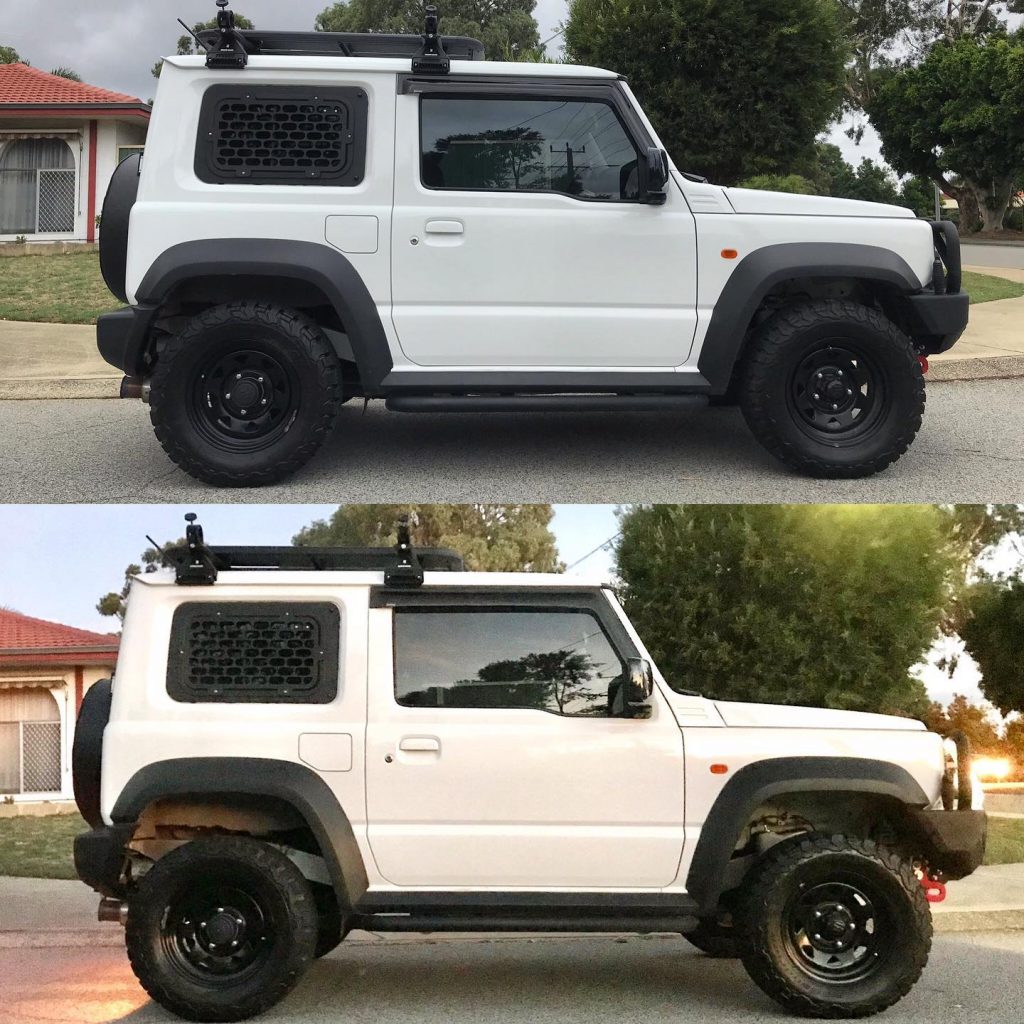
Introduction
Sections
- Stuff you need to know
- What tools do you need
- Preliminary stuff
- Front install
- Rear install
- Caster correction installation if needed
- Steering damper
- Do you need to do a wheel alignment?
- Technical stuff
- Standard versus lifted heights
- Brake line lengths
- Spring rates and lengths
- Shock dimensions
In a way this guide is something that isn’t brand specific. Certain lifts for the JB74 have different parts but the basics are the same: springs, shocks, +/- caster correction and brake line swaps.
There’s a couple of difference to the previous models. You need longer brake lines if you go beyond about a 45mm lift at the front at least, and also drop the crossmember underneath the front driveshaft if you go above 50mm. Some people report with shorter lifts and caster correction that they also need to drop the crossmember (or remove it). We’ll discuss that in the front installation info.
Certain things about a lift can be regarded as optional. Caster correction, for instance, doesn’t appear to be essential as it depends where you car was standard w.r.t. caster. Wheel alignment also is simpler than many people make out. Panhard rod adjustment to centre the body on the chassis also depends on how that is from the factory: if your car is offset one way and you lift it and it gets worse you need it, but if your car was offset the other way and lifting it corrects it then happy days.
Is it essential to lift?
No. It does improve the stability of the car to improve the shock absorbers and if carrying any weight then the slightly stiffer and taller springs of a lift is also super useful in those situations. I had this lift kit sitting under my bed for ~18 months before fitting it because finding a day to document fitting it wasn’t easy… and the car was more than capable without a lift.
It looks way better with a lift, though.
Why this lift kit?
I wanted to do something different to what people were doing when I bought the car, which was either a Tough Dog lift (for all the stuff it comes with & multiple height options) or an ARB/OME lift (because it was engineered to suit the car in conjunction with Suzuki Aus). Since I bought it other lift kits have come onto the market including the Ironman GVM upgrade.
I also really like DIY stuff (obviously, given this site) and I wanted to do it myself to write it up to demystify lifts for people & also demonstrate how easily it can be done at home.
What tools and stuff do I need?
- Jack
- Four jack stands
- 8, 10, 14, 17, (19mm) spanners
- 10mm flare nut wrench for brake pipes if changing brake hoses
- ~6mm or shifter to hold the top of the front shock absorbers to tighten them up
- 10, 14, 17, 19mm sockets, ratchet handle, and a long breaker bar to suit
- Torque wrench
- Stuff so you can bleed the brakes if you’re changing brake lines, like clear hose or a one-person bleeding kit
- Brake hose clamp to minimise fluid loss if changing brake lines
- Brake fluid if changing brake lines
- Needle-nose pliers or some other way to ping off brake hose circlips
- Potentially a small tiny file for any adjustments to the light bracket needed
- Some medium strength (blue) threadlocker for shock absorber bolts
Preliminary stuff
When doing this job, you need a fair amount of room underneath the car to drop the axles low enough to easily remove the springs. There’s also bonus points for having the car high enough that you can refit your wheels once you’ve lifted the car… the extra suspension down travel of longer shock absorbers can make it challenging!
I didn’t actually get mine quite high enough with the jack stands I have and that’s ok, just requires jacking up under the axle to lift it up a bit against the suspension before you refit wheels at the end… but if you get it high enough then you save that bit of time right at the end when you just want to get inside and have a nice refreshing beverage.
The kit I have bought – the Black Raptor premium 2″ lift – comes with adjustable shock absorbers. I set these to the middle of their adjustment settings and will play with them and report back suggested settings after some time with the car. They have a dial on the bottom of the shock that you turn right or left and it clicks for each of the adjustment points. Easiest way to find the middle is to turn it all the way loose, then count the clicks to all the way tight. Then turn it back half those clicks to the looser setting.
Before you lift the car though, loosen the wheel nuts. This is way easier with the car on the ground.
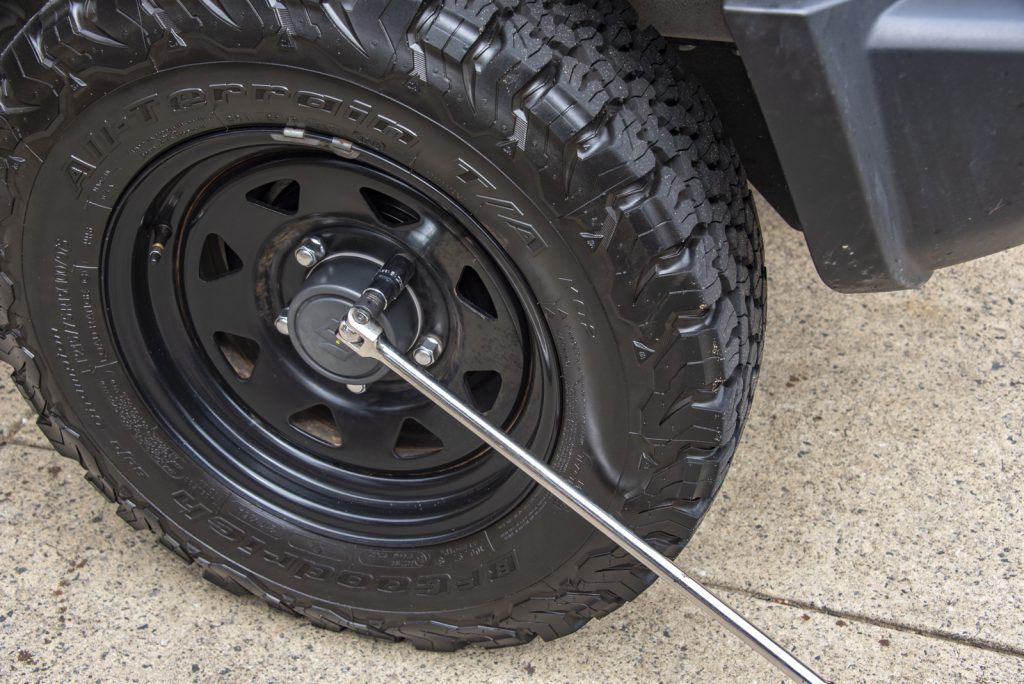
Once the wheel nuts are loosened a little, lift the car up by the chassis and support it with jack stands under the chassis rails.
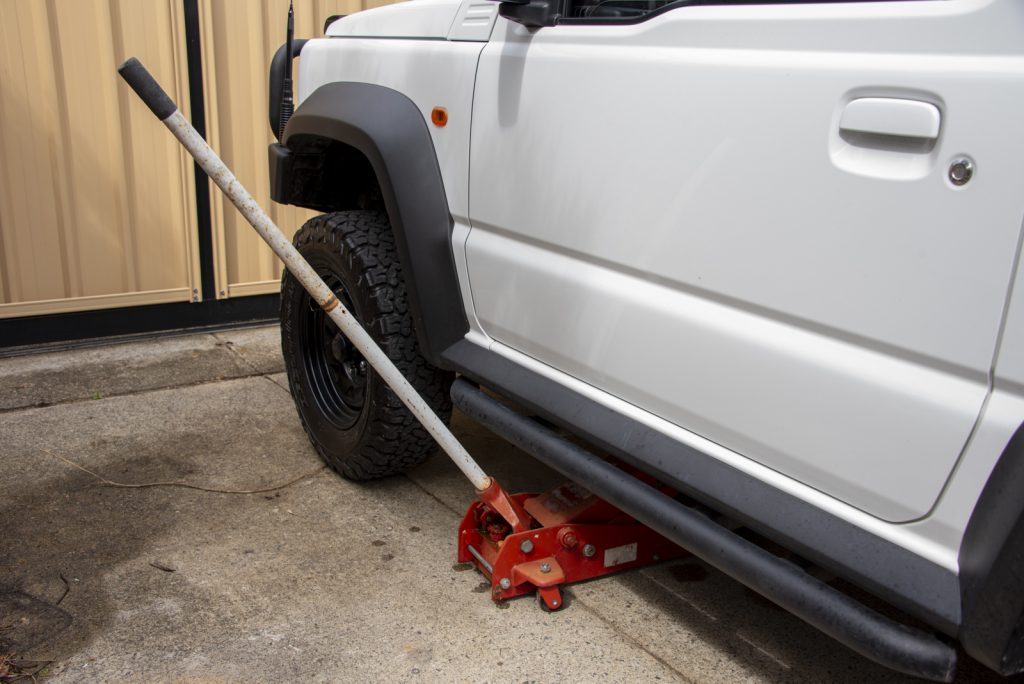
I find it’s sensible to lift the front first with the handbrake on to stop the car rolling back as you lift it, and then lift the back. When lowering it afterwards reverse this procedure.
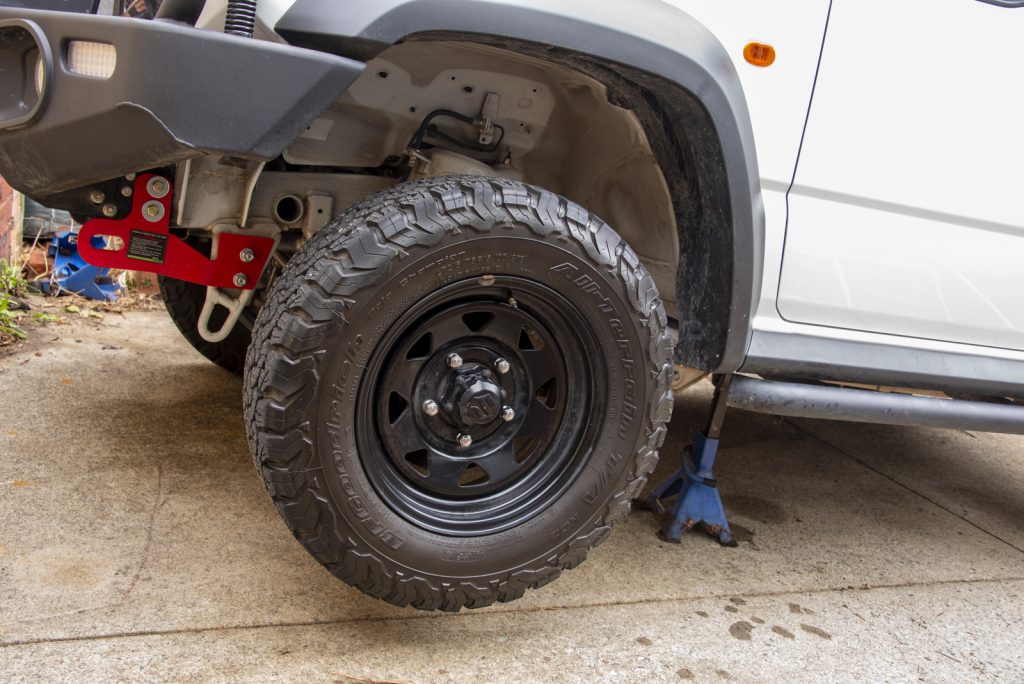
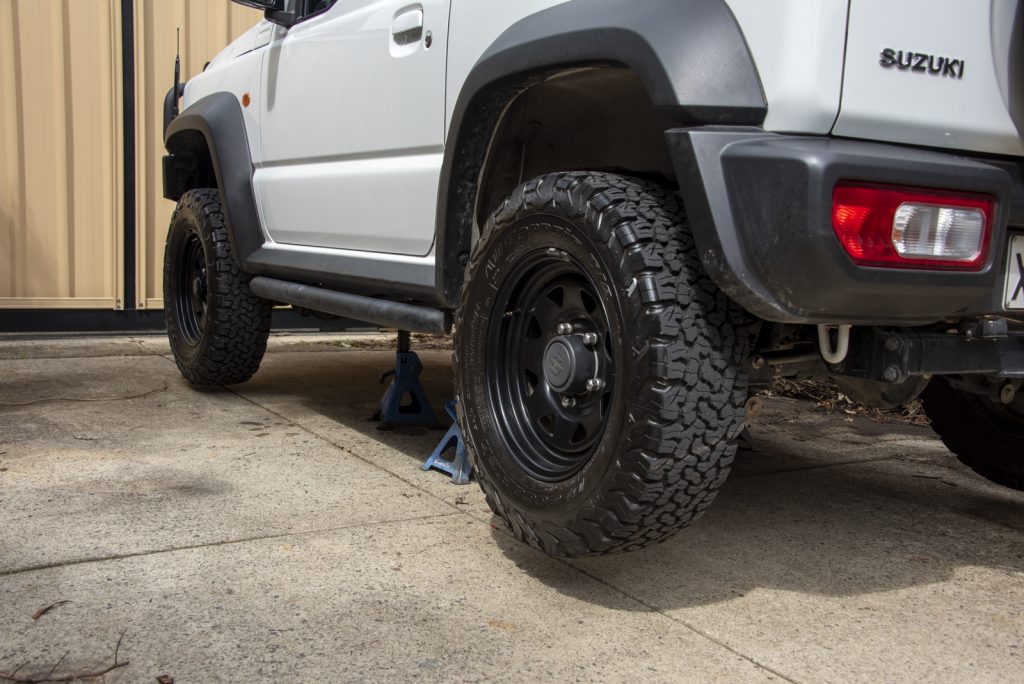
With that done it’s time to get with the installation. I did the rear first then the front but I’ll write it up front to back
Front
The front is quite straightforwards, and I think the sensible thing to start with is to remove the crossmember that runs underneath the driveshaft. If you are fitting a small lift (< 50mm) this isn’t required to be changed for a lower one, but you will hit the front driveshaft against it as you lower the axle to remove the springs anyway. On the other hand, if you are running a lift of ≥ 50mm then you need to either remove it or run a crossmember with increased clearance so might as well get it out of the way now.
The crossmember comes out with two 14mm bolts/nuts each side. The bolt heads can be coated in anti-rust stuff so might be a challenge to get a spanner on to hold them when you undo the bolts. In the below pic I show the heads of the bolts and their anti-rust coatings… the nuts are on the other side of the crossmember but fairly obvious.
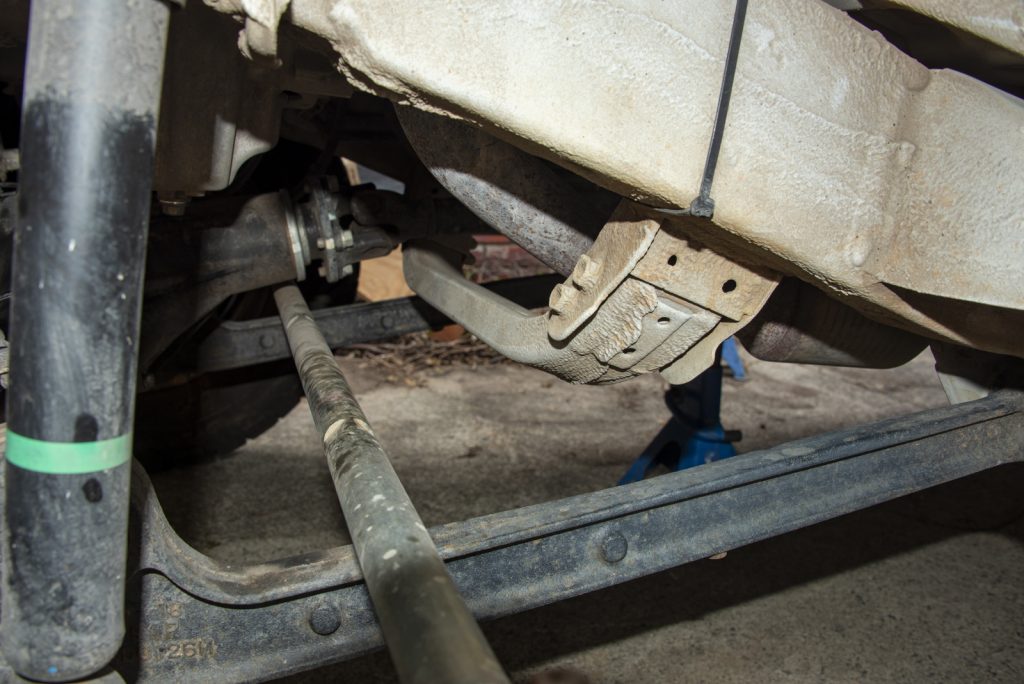
The JimnyBits 2″ kit comes with a complete crossmember to replace the factory one.
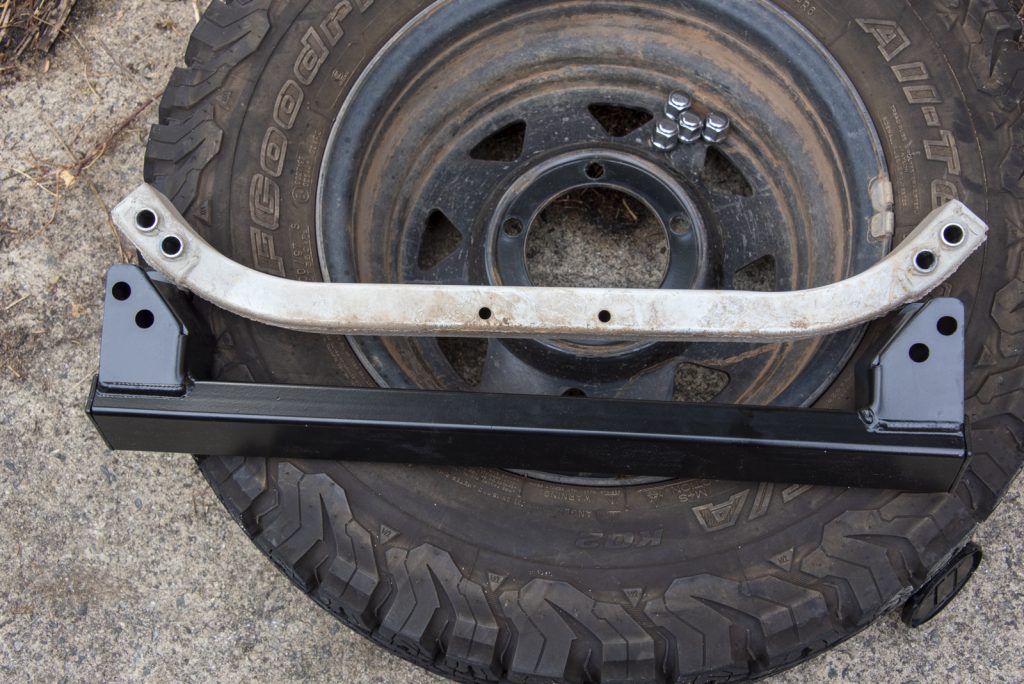
Some other lift kits come with brackets to drop the factory crossmember, and some people just don’t use it. This crossmember basically stiffens the chassis compared to a JB43 so it’s probably not *essential* but the chassis will flex more without one. There also exists a nice one which actually runs ABOVE the driveshaft, removing all clearance issues and also gaining further ground clearance.
Re-installation doesn’t really need a picture, but you tighten up the bolts. Not really difficult… torque isn’t specified in the manual but probably 59 Nm.
The next thing you need to do is release the brake hoses a bit. If you aren’t replacing them you don’t need to fully remove the hoses but unclipping the middle connector helps a heap with lowering the axle.
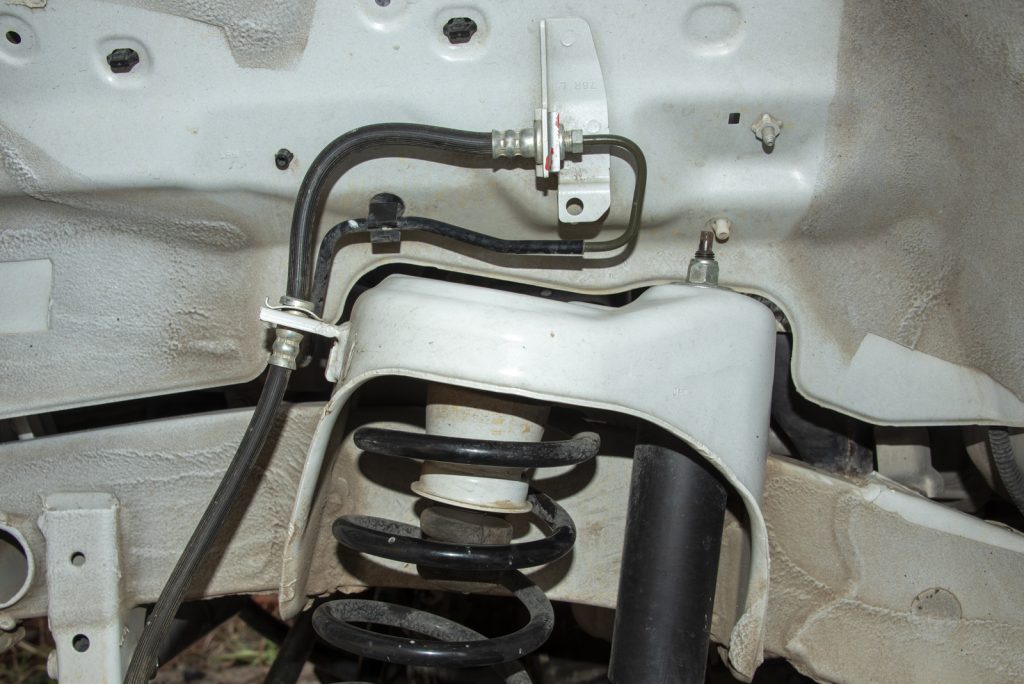
Undoing the circlips holding the brake lines to the body can be frustrating, but if you use long handled pliers and squeeze them with one end against one of the ‘tongues’ and one against the metal part of the brake pipe they end up getting pushed off. They can fly off at great velocity though…
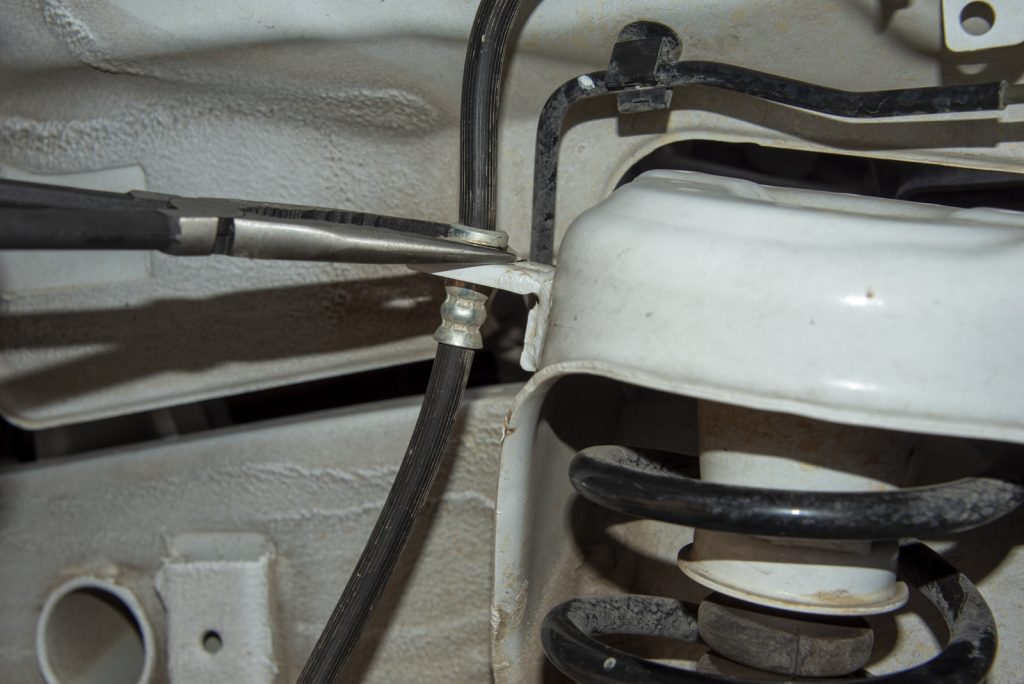
With the clip released out of the middle holder at the front, you can then push the hose down a bit and then it comes out of a slot in the mount while remaining connected at the ends still.
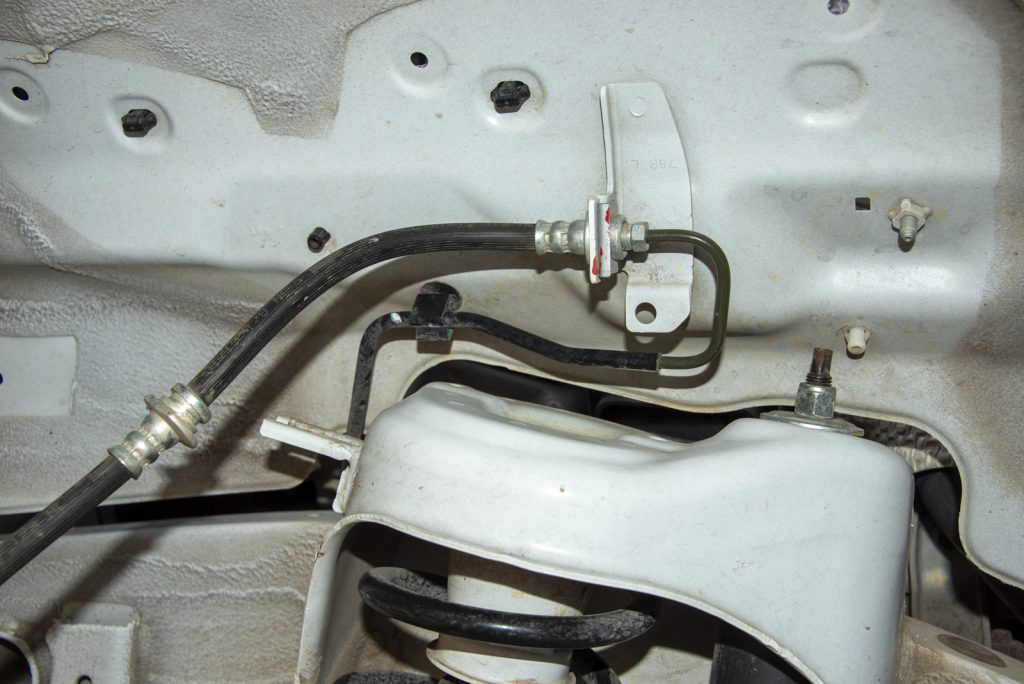
If you’re changing brake hoses now is the time to do it. The way I like to do this to minimise fluid loss (and hence the amount of time I need to bleed the brakes after changing the hoses) is:
clamp the existing brake line
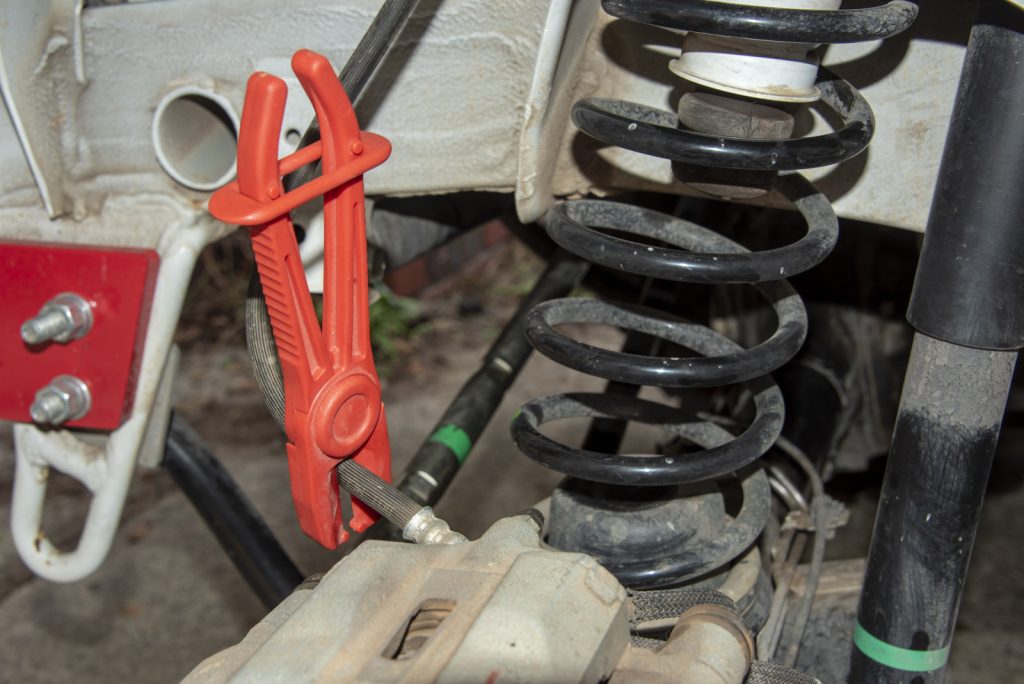
get the lines slightly cracked at the bolts (don’t judge me for not using a pipe/flare nut spanner… I would suggest doing so)
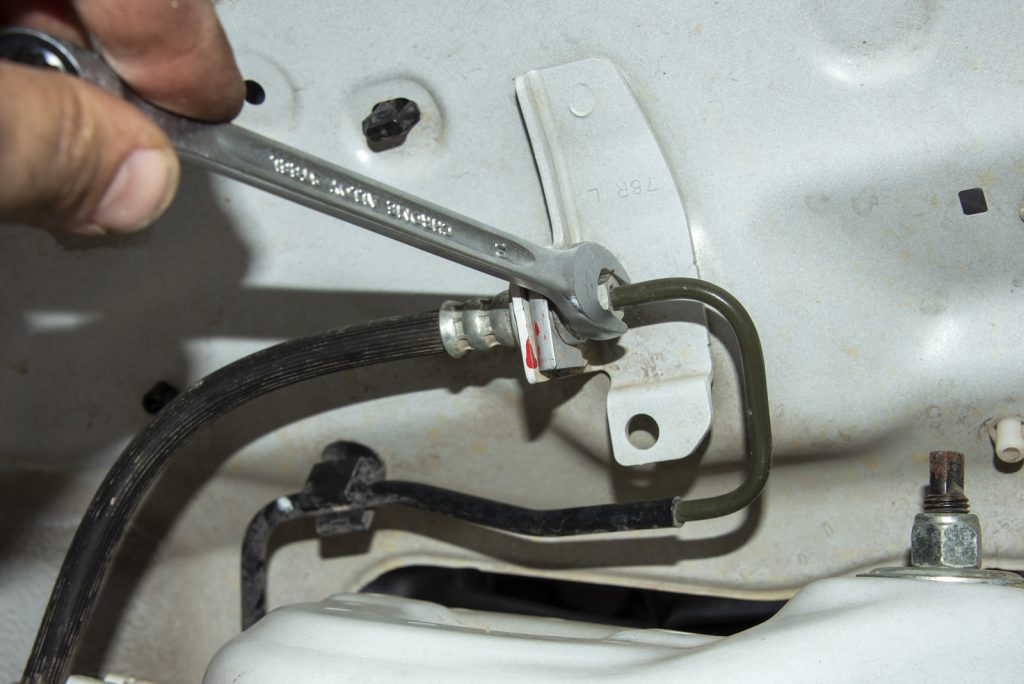
then undo the circlips just like above

undo the caliper end bolt noting it’ll start pouring fluid out from the caliper as soon as you do this
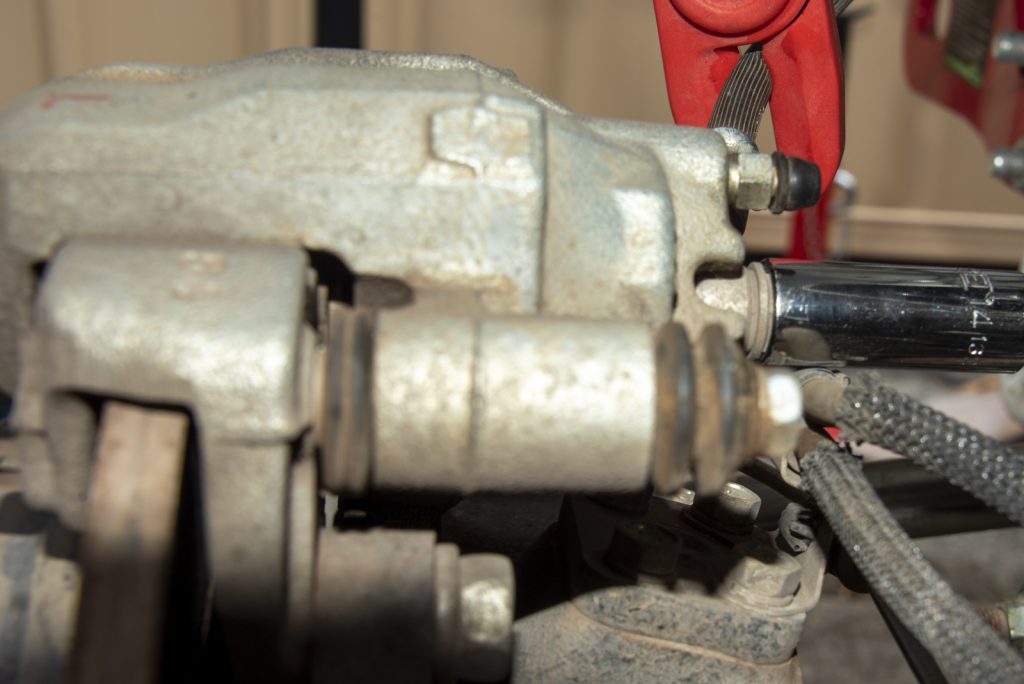
immediately fit the new caliper end bolt with its new washers to stop the fluid coming from the brake caliper
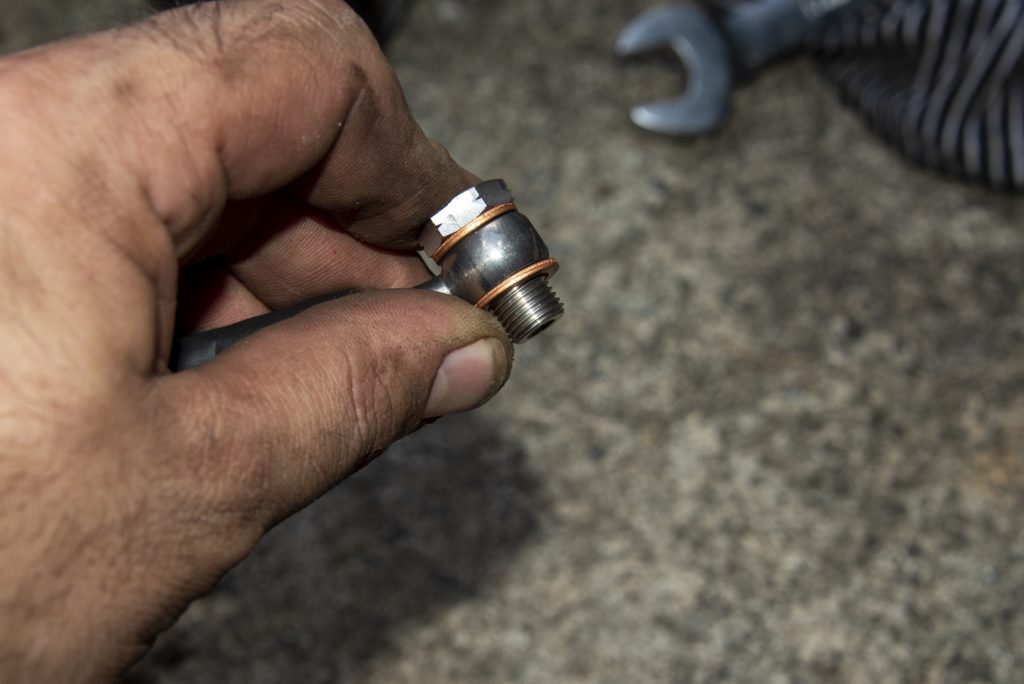
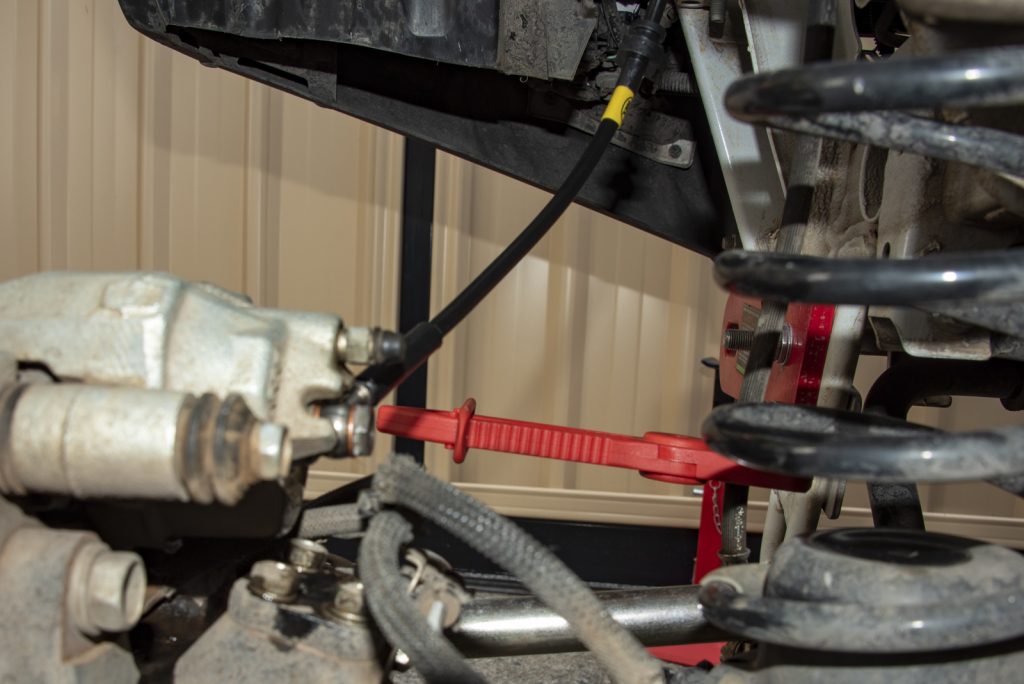
undo the upper hose nut, which will start pouring fluid everywhere (hence no picture), then immediately fit new brake hose to upper pipe connection, and tighten up with a 10mm flare nut spanner on one side and a 17mm spanner on the other if you’re using typical replacement brake hoses. Then it just clips onto the factory mount as per the original.
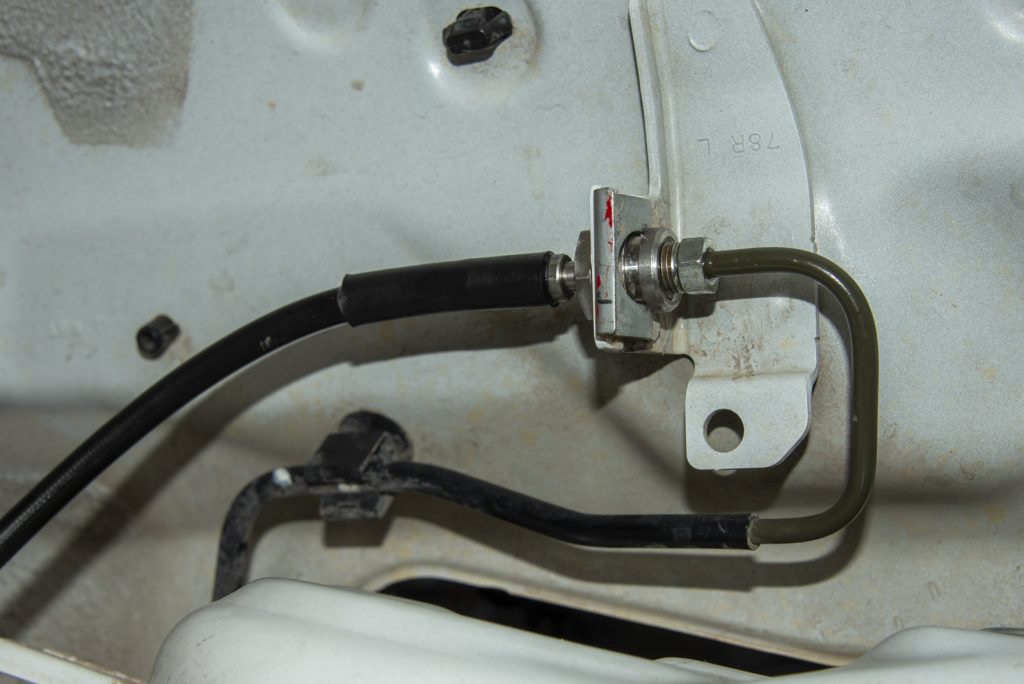
With the brake hoses swapped it’s a good idea to bleed the brakes. I actually did this for each side as I went rather than trying to do it all at once at the end.
Bleeding is quite simple, I used a one-man bleeding system from Supercheap although there’s lots of options here. You only are introducing air pretty close to the caliper itself so it’s fairly easy to bleed and it does essentially gravity bleed itself as you do it.
Start by putting your chosen bleeder setup on the bleed nipple for the caliper you just swapped the brake hose on. With the hose on, undo the bleed nipple (10 mm on the front).
Air will start coming out first so you won’t see any fluid. You can actually just leave it for a while here till you start seeing both fluid and air coming out.
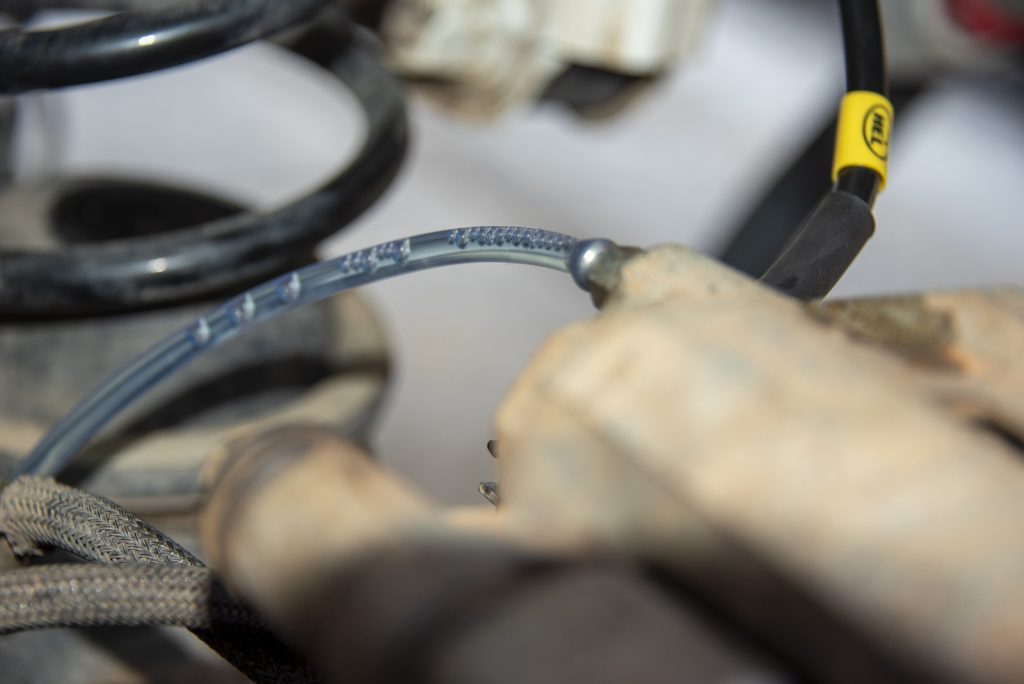
Once this has started you can give the brake pedal a bit of a pump to force more air and fluid through. Go all the way down with the brake pedal in nice smooth and steady pushes. Note that with the engine off the brake pedal with have a lot more resistance than you’re used to feeling, but with the bleed nipples undone the pedal will go all the way to the floor.
Once you’ve done that a bit and there’s only fluid coming out of the nipple, tighten up the nipple and you’re done with that side. Clean up the split brake fluid with brake cleaner or water or similar.
Don’t forget to periodically top off the master cylinder reservoir with fresh brake fluid. Don’t run this out, it makes the whole process a lot harder!
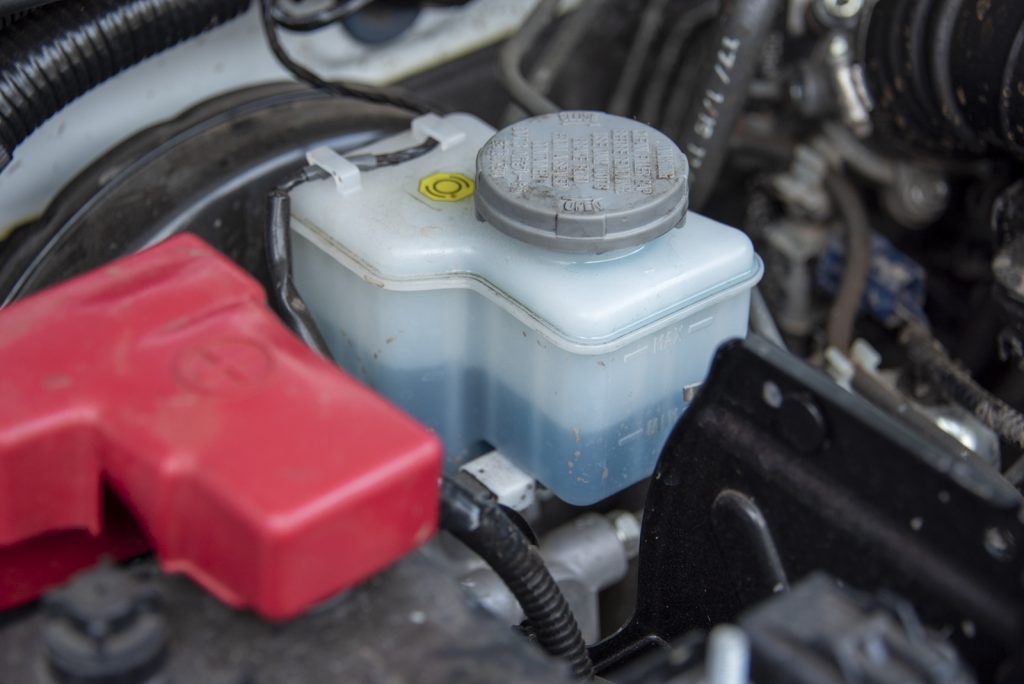
I also found that I needed to partly release the brake calipers from their mounts to get the axle low enough. This isn’t too hard, you just undo the ‘front’ bolt completely, and loosen the back one a little, and let the caliper rotate up. Hard to photograph from the back but release the lower of the bolts that mount the caliper to the axle itself, not the higher up bolts on the caliper which are the caliper slide bolts. The position of my ratchet here gives away what bolts to undo.
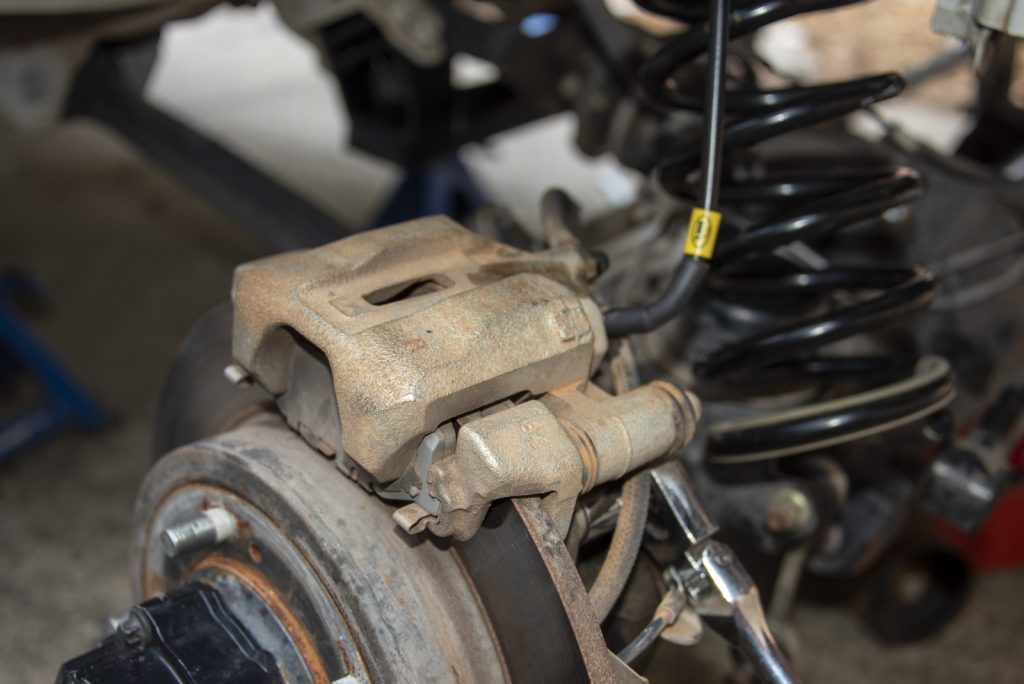
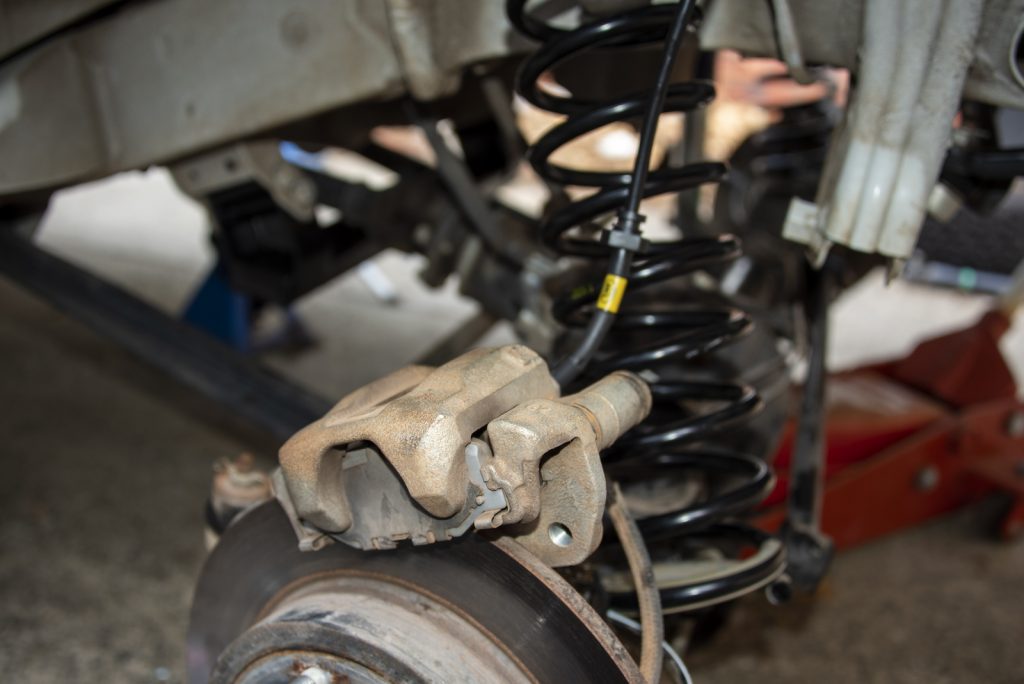
Before lowering the axle you need to support it underneath with your jack and remove the shock absorbers. With the axle *just* supported, either undo the top or the lower mount… top is probably easier to get to, bottom isn’t terrible either.
Top is undone by holding the small flat sided rod with a really small spanner, and a 14mm spanner undoes the nut. Bonus points if you use a ratchet spanner here but it’s doable, albeit slower, with a normal spanner.
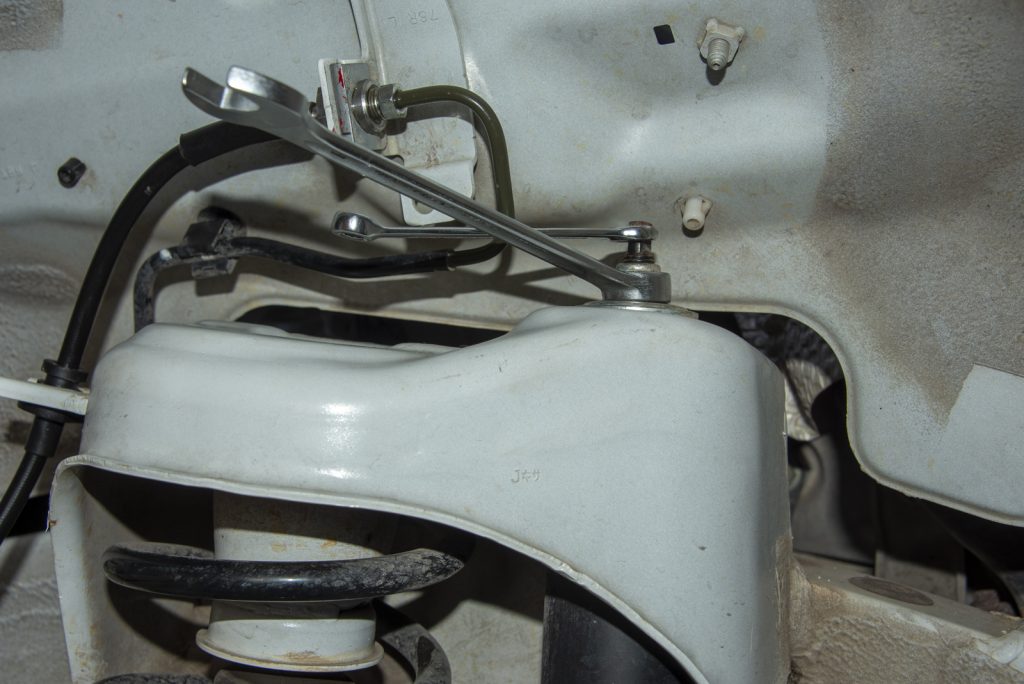
Lower mount is 17mm on both ends. The back side is a nut which is very close to the radius rod so you’ll need a spanner in there to hold it. The bolt head is pretty easy to get to with a ratchet with a socket on it, though.
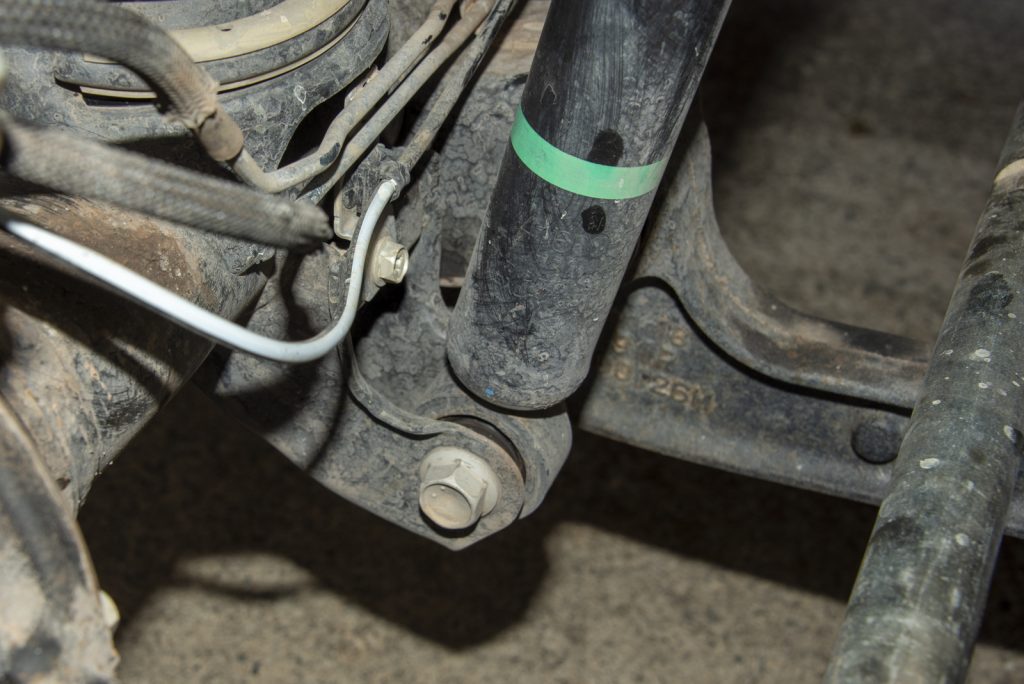
For refitting, what I found easier was to put the new shock into the lower mount and do it up finger tight, and then change out the spring.
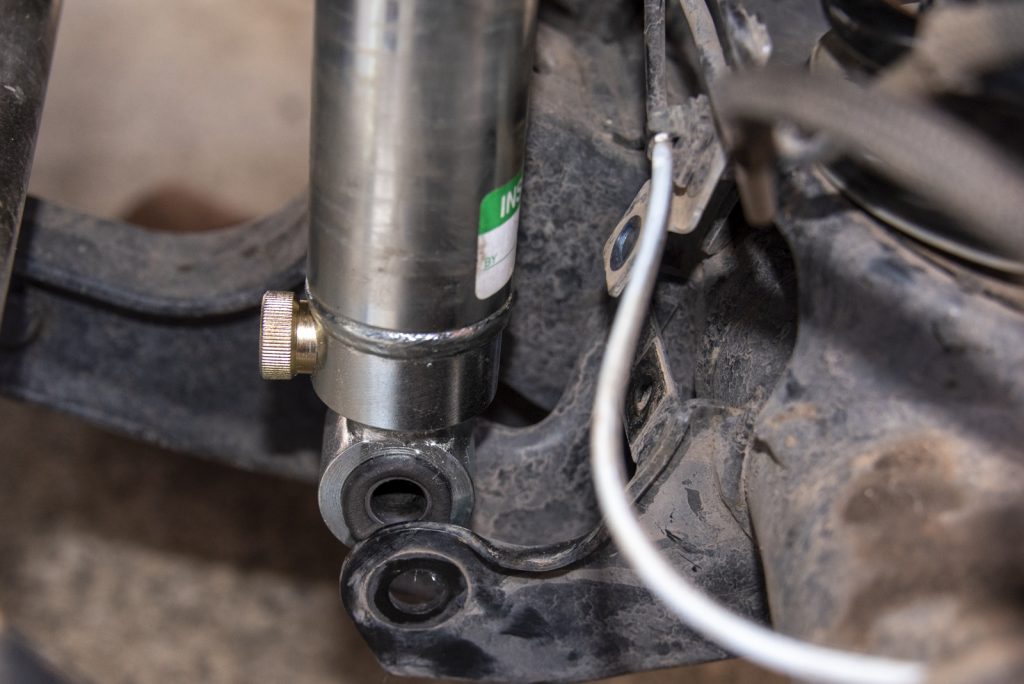
Then when you lift the axle back up against the spring, line the shock up and put the top nut on. It can be tricky with new bushes as they need a lot of squishing down, just start the nut very carefully so you don’t cross thread anything.
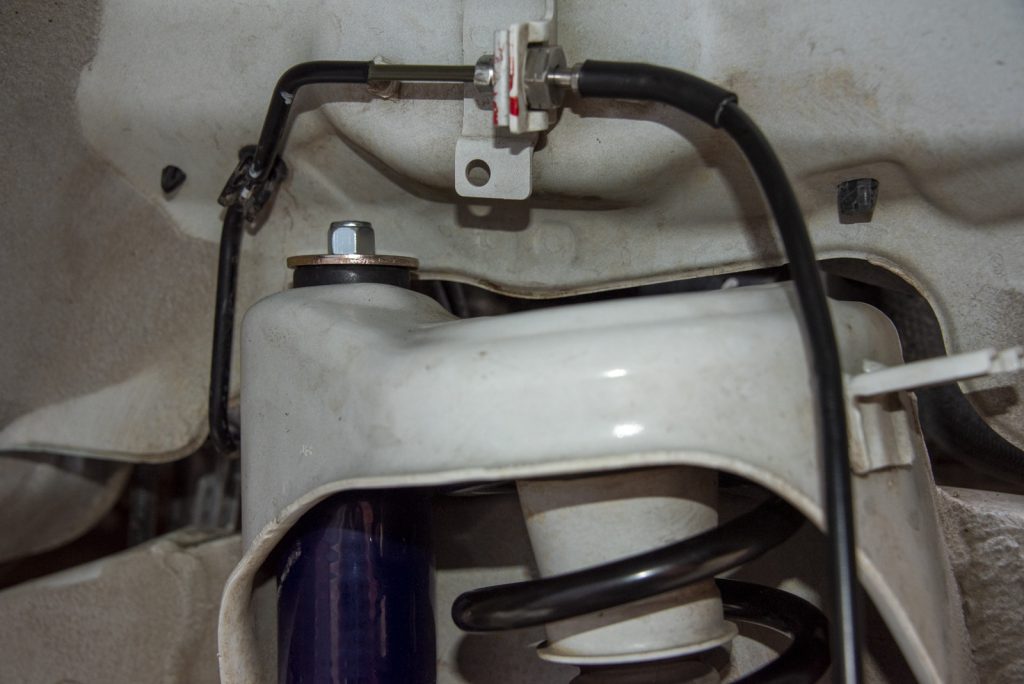
Lower shock bolt is torqued to 60 Nm, upper nut is 35 Nm but without a crows-foot spanner you will struggle to get a socket in there to torque it up. I always like to do these with suspension loaded i.e. jack up the car till it is just about to lift off the jack stands under the axle, and then torque up the bolts.
With the shocks released from the top (now you’ve refitted the shocks at the bottom mount) you’re almost ready to lower the axle, but first a few things need to come off.
The workshop manual suggests releasing the panhard rod at the body side. I’m not sure this is necessary but I did do this. Undo the clip on the bolt and then undo the 19mm headed nut. Note this is done up really right so use a long breaker bar to undo it.
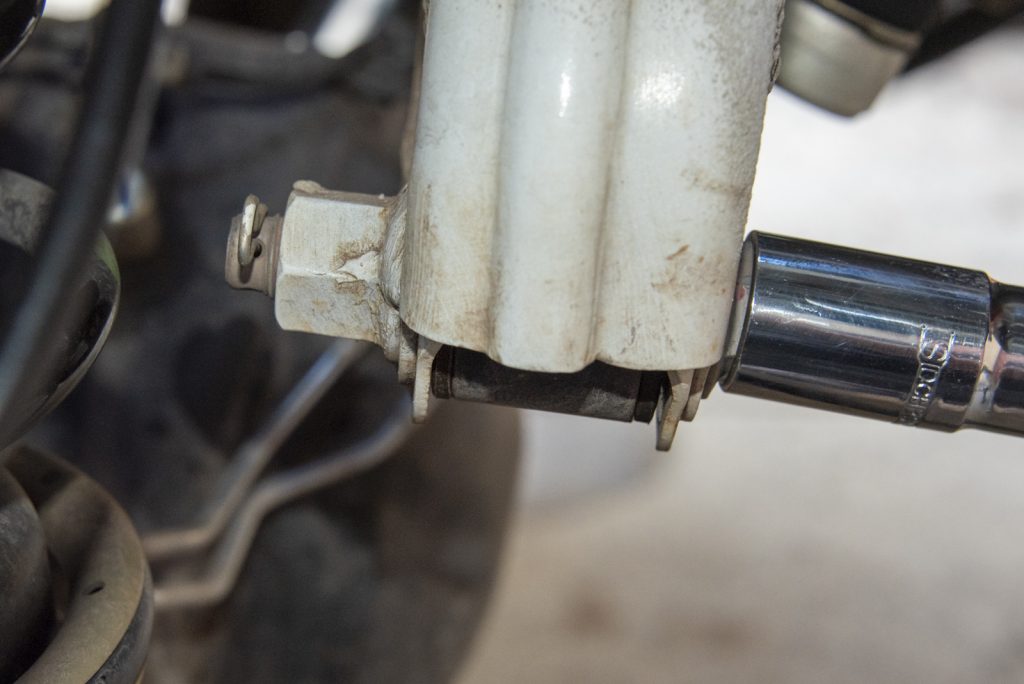
The other thing that makes sense to do is to undo all of the mounts on the right hand side (drivers side for Australians!) that hold the hoses to the axle where they come down from the body. This gives you enough wiggle room to lower the axle and get the springs out without straining any hoses. You don’t need to disconnect everything, just the 4 10mm headed bolts that hold the various brackets to the axle. You also want to just release the wheel speed sensor wire, and the two vacuum hoses, from their little clamps at the back of the caliper.
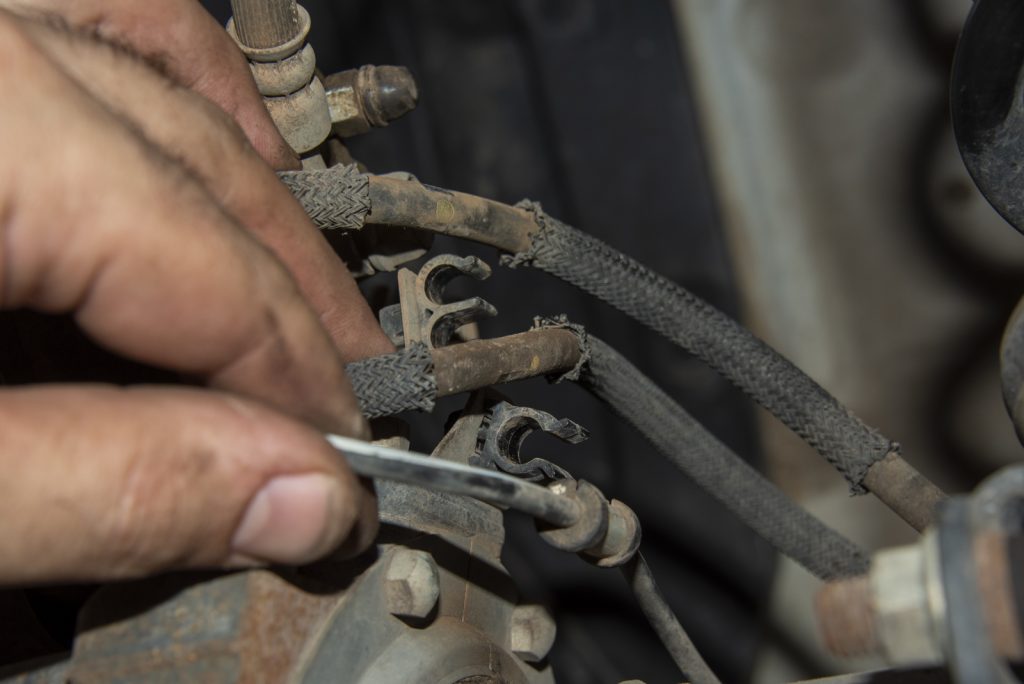
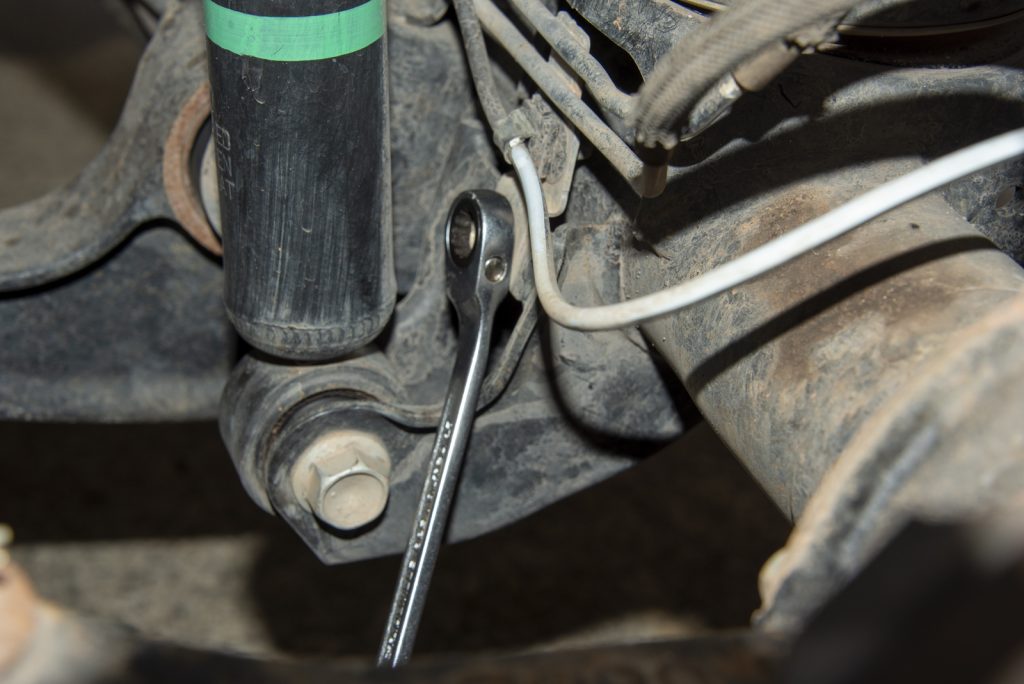
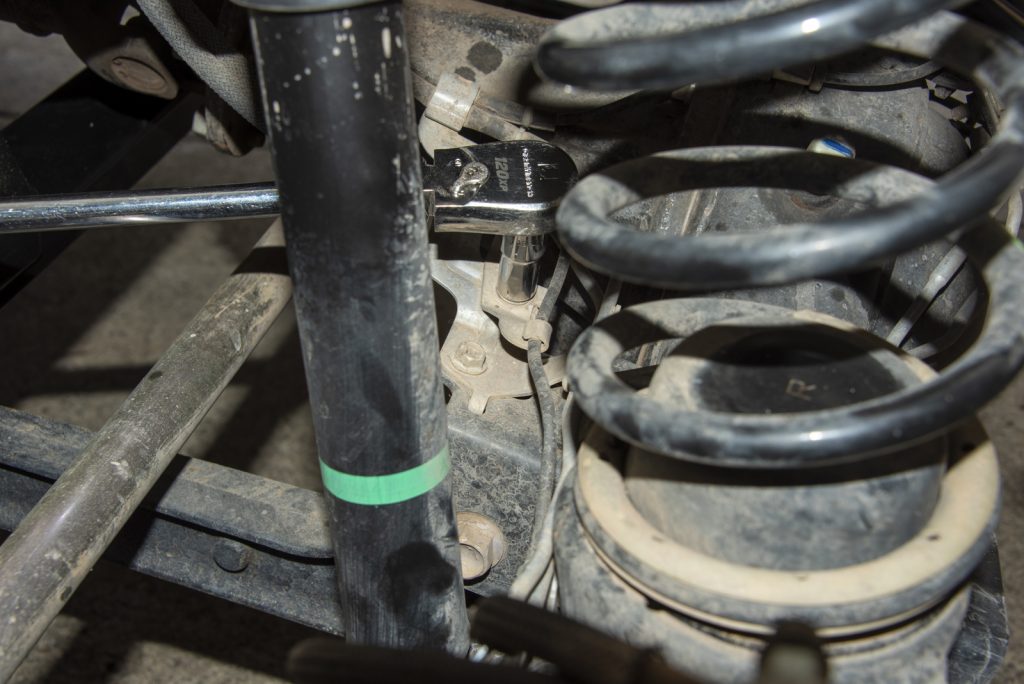
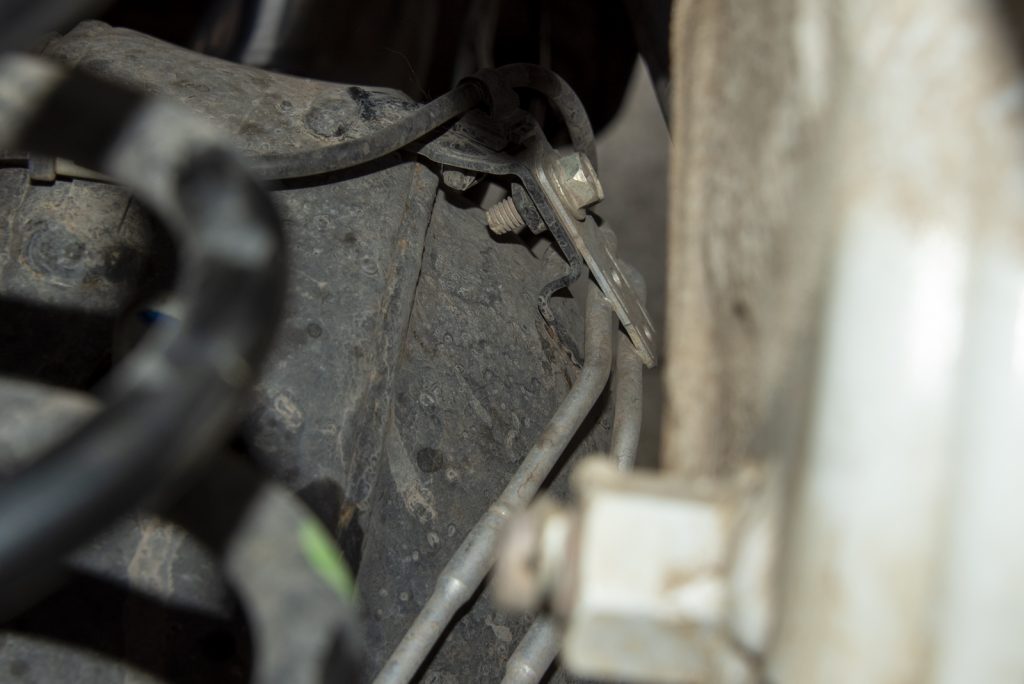
With those four bolts and hoses/wire unclipped from the back of the right hand side caliper, there’s enough slack to let the axle lower as you lower it with shocks disconnected to get the springs out. You only have to do this on the right hand side because that’s where the vacuum hoses and wheel speed wires come from.
The final thing to release is the swaybar end links. Bit of a pain to do this with a ratchet but probably doable, in my case I used an impact gun to just buzz them off which worked a treat. Slightly easier to access the lower of the bolts i.e. right on the end of the swaybar. Disconnect the swaybar at both ends.
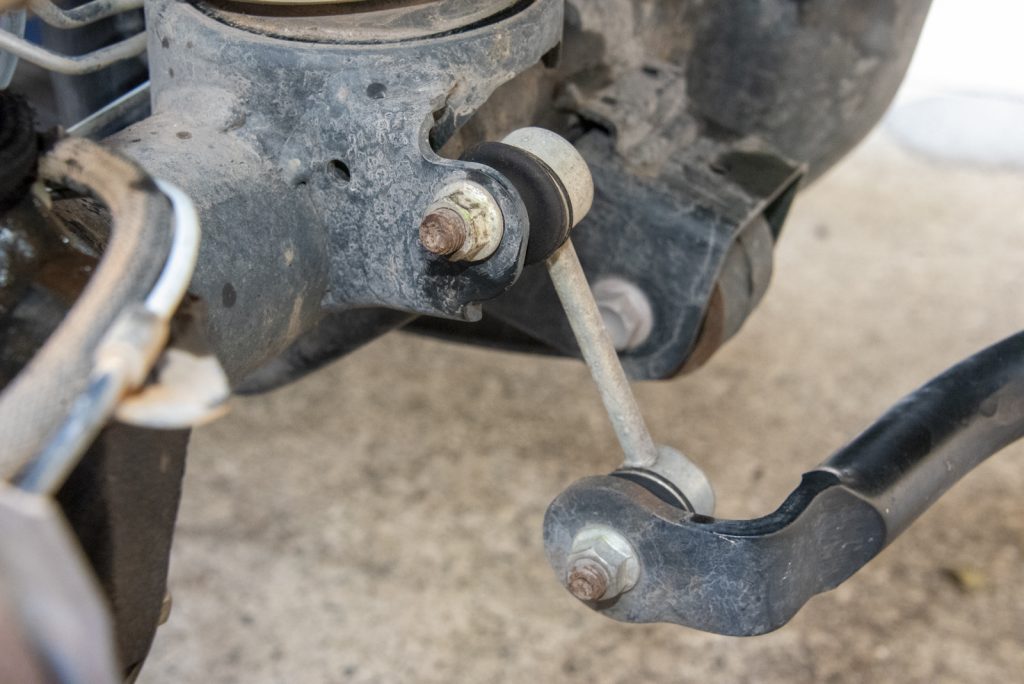
Before you lower the axle and release the springs, a bit of a checklist
- Axle lightly supported underneath by jack.
- Crossmember removed and (if required) replaced with dropped crossmember.
- Brake hoses released from intermediate clips and (if required) replaced with extended hose. Caliper front bolts undone, rear bolts lightly released so caliper can pivot.
- Shock absorbers released from their top mounts, potentially replaced with new shocks attached only at the bottom mounts.
- Vacuum hoses and wheel speed sensor wires unclipped from back of right hand caliper, and mounts on right hand side holding hoses released from axle housing.
- Panhard rod disconnected at body end.
- Swaybar ends released from axle housing.
With that done you’re now at the easy part! Release the jack and slowly lower the axle. You’ll eventually get to the point where the springs just can come out.
Once the old springs are out, you can take the bottom plastic noise dampers from the standard springs and put them on your new springs. These just stop a bit of rattling.
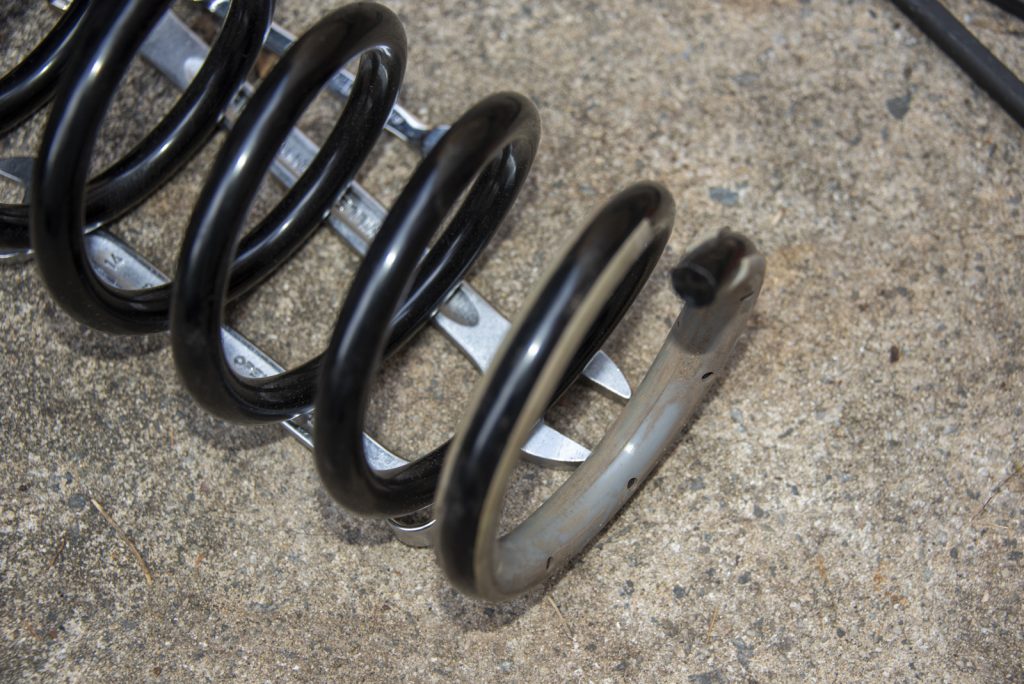
Note that my kit was an early one so I’m not sure it is representative of how they are supplied now… but mine came with zero instructions. There were 3 springs: two of the same length marked 1500, and 2 longer ones which were marked 1100 and 1000 respectively, with the 1100 one being a little longer than the 1000 marked one. My understanding is the equal length ones go in the back, and the 1100 spring goes into the drivers side and the 1000 spring gets the passengers side at the front. Easy peasy. I might be wrong, and it is different in that some lift kits run different rear springs rather than different front. In any case, that’s how I did it and it seems fine.
When you refit your new springs, get the spring end at the bottom so it sits between 0 and 10mm back from the ‘end’ of the spring seat. This ensures it isn’t sitting incorrectly (too high) on the axle, but also gives enough space for the corresponding end up in the top mount to sit correctly.
At that point you just lift the axle up and do up the shock absorber top mounts, do up the caliper bolts, do up the four vacuum hose line mounting brackets, and clip all the hoses into their correct position. You can now do the swaybar end links, then tension up the shock absorber mounts. Then pull the panhard rod end back into place and tighten this up to 150 Nm… and then it’s just checking everything is tight, putting the wheels back on and the front is sorted.
Rear shocks and springs
We start the rear off the same as the front: jacked up in the air, wheels removed.
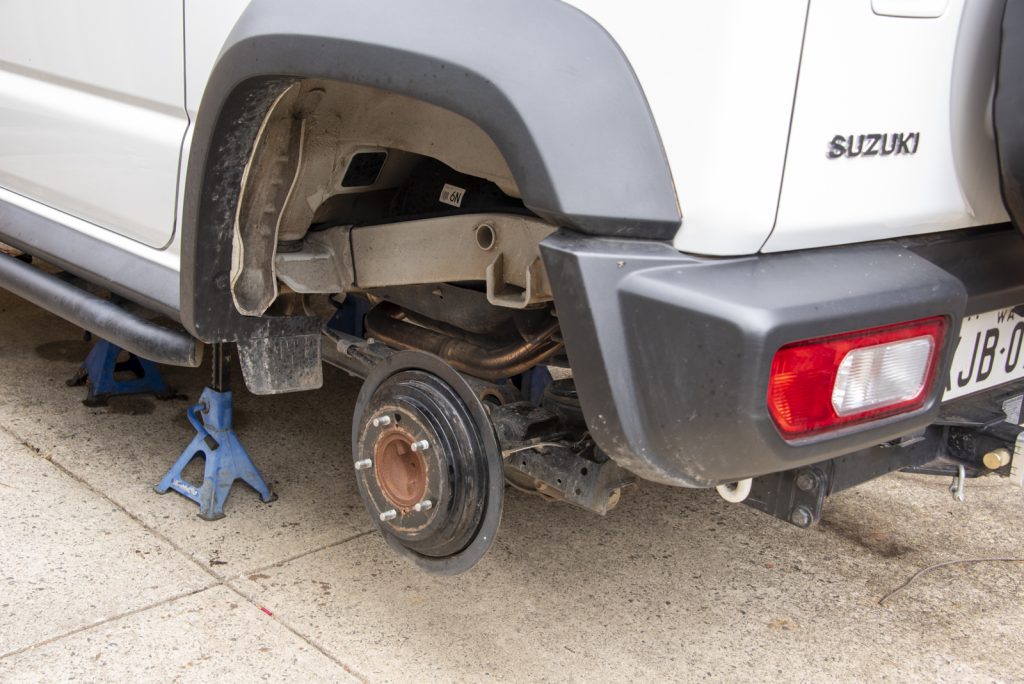
First thing to disconnect is the auto levelling headlight sender unit if you have them fitted (all Australian ones do). There’s 2 10mm bolts right at the top, a little clip to unclip the wiring harness where it attaches to the mounting bracket, a wiring connected that you have to push in a little tab with your thumb to remove it, and one 10mm headed bolt down where it mounts to the axle.
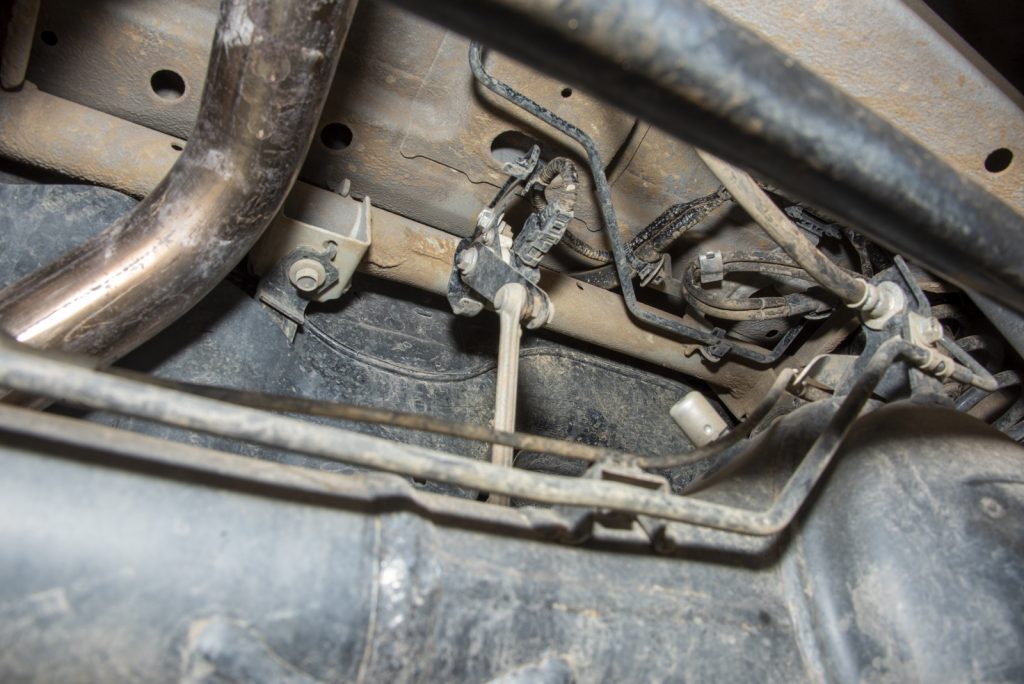
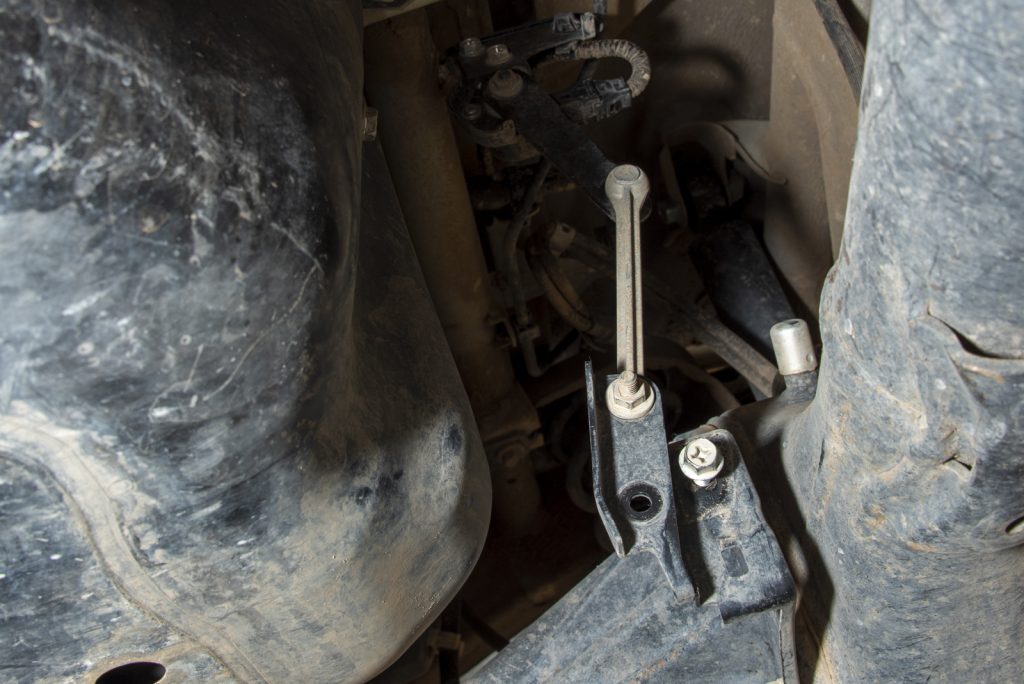
The reason you have to take this off is the bracket will bend as you lower the axle to release the springs. The other reason is that you need to account for your lift with the levelling system – kits should come with a bracket to offset this. The Black Raptor kit came with a replacement arm but I understand some others just lift the lower mount.
To fit the new arm, you push the arm all the way to rotate the sensor counter-clockwise and undo the nut to the sensor with a 10mm socket. This reveals the actual connection to the sensor, note it has a little curve on one side of the pivoting peg.
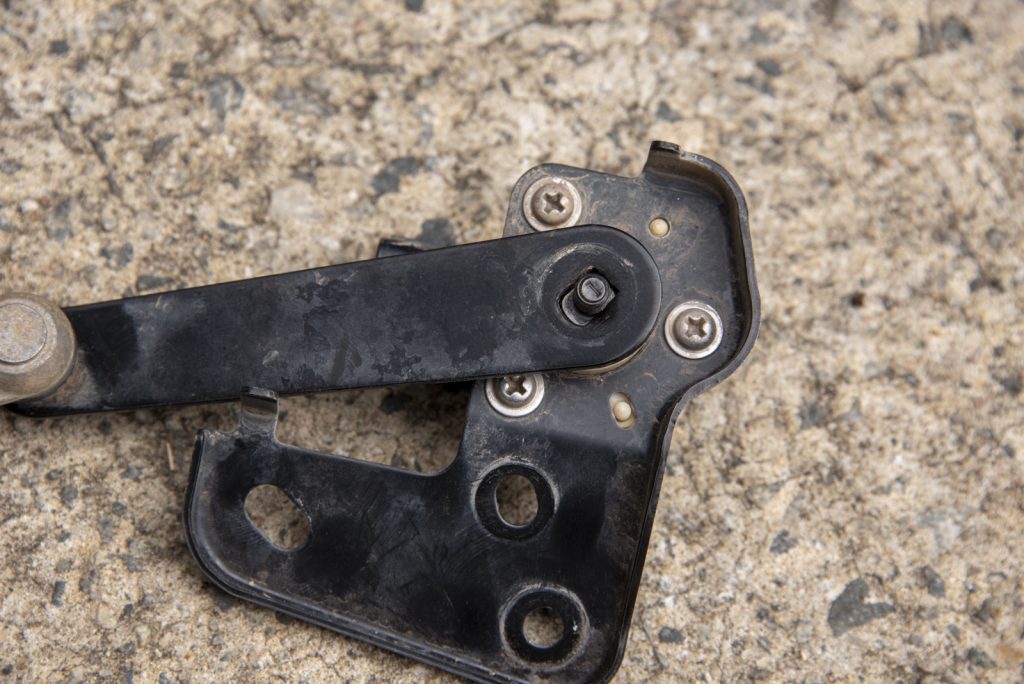
Undoing the other end of the pivoting arm requires both a 10mm socket and a 10mm spanner, or two spanners. The spanner holds the ball joint shaft, and then the other 10mm tool undoes the actual nut.
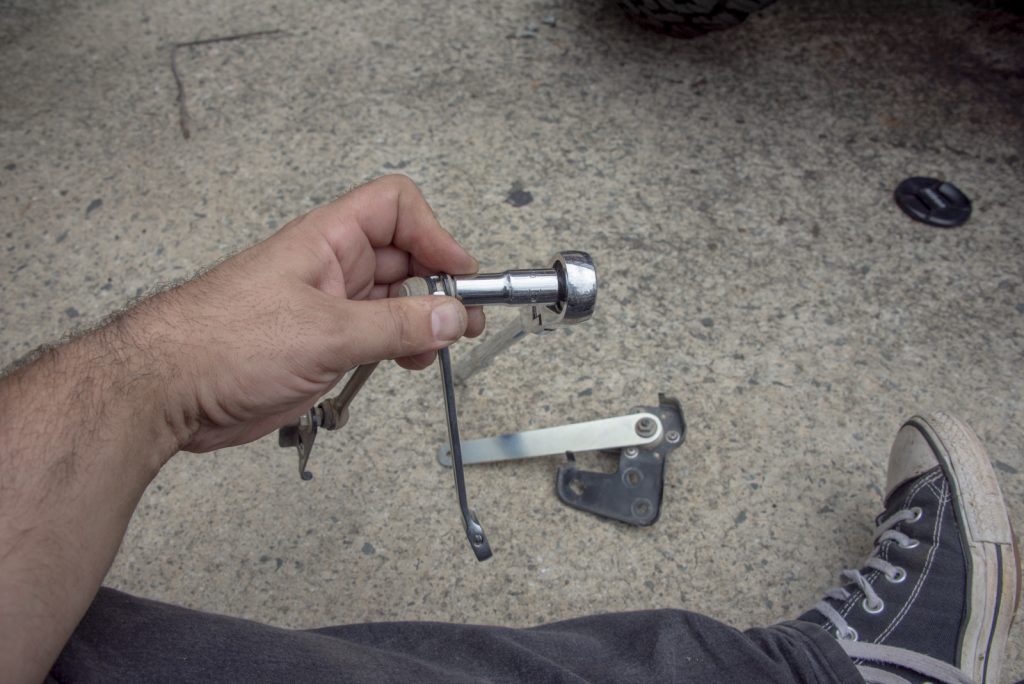
You then fit it all back together with the longer arm and one modified light levelling unit is sorted… don’t refit it till after you’ve lowered the axle and dropped the springs though!
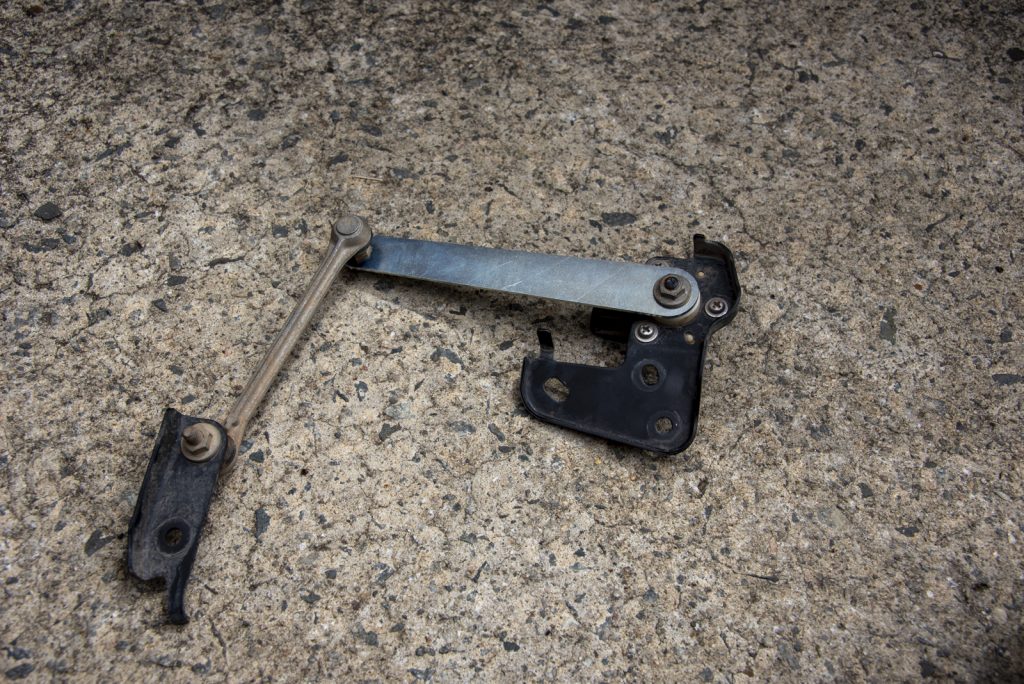
UPDATE! I have gone back to the standard headlight pivoting arm but I’ve replaced the linkage to the axle with an adjustable Taniguchi item. This lets me get the movement perfect so account for the extra travel and also the extended down travel with the shock relocation brackets. This installs pretty easily and it’s an adjustable rod. I popped the springs out to verify how the linkage moves at full bump and full droop and adjusted to make it work correctly. Easy peasy install.
The other thing you need to release before you lower the axle is the various mounts for the brake lines and also the wheel speed sensor wire mount at the top of the diff pumpkin.
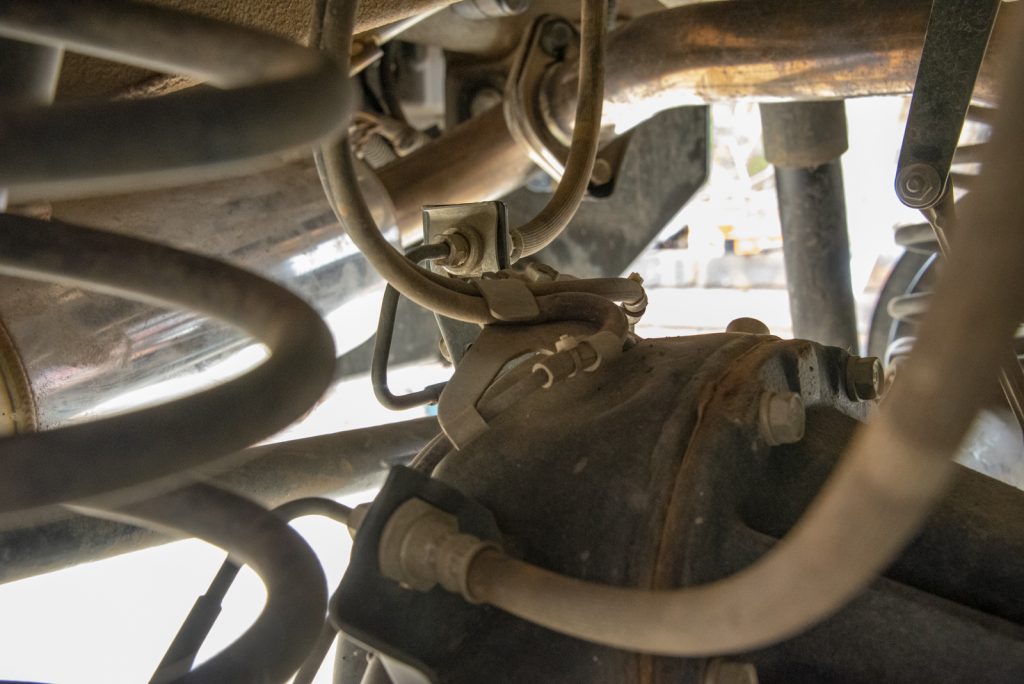
My kit did come with replacement hoses but they seem to be about the same length as standard. I will need to replace them with longer ones as I have rear shock relocation brackets that give more down travel, straining the hoses. In any case, you need the hoses at least unclipped from their mounts so they can move as you lower the axle, as you will over extend the hoses otherwise.
I swapped the hoses at this point to my replacement hoses; because I need longer ones I have left their ‘upper’ mounts unclipped and cable tied them to the chassis out of the way temporarily. Same deal as the fronts: clamp hose, undo bottom flare nut, replace new hose, undo top flare nut, immediately connect to new hose, bleed brakes on each side as you do this.
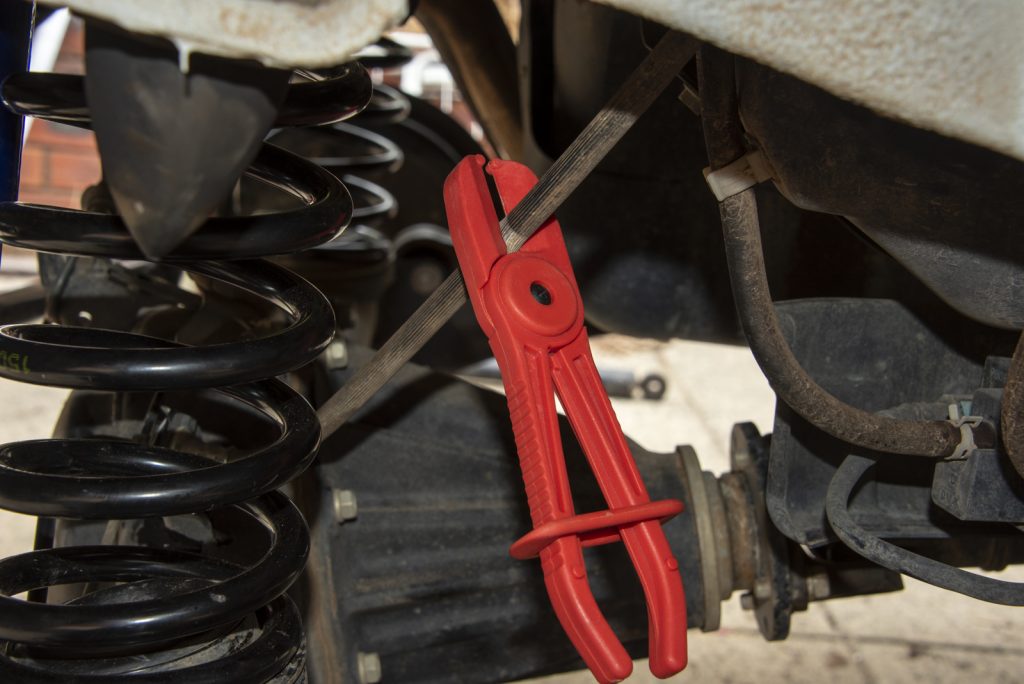
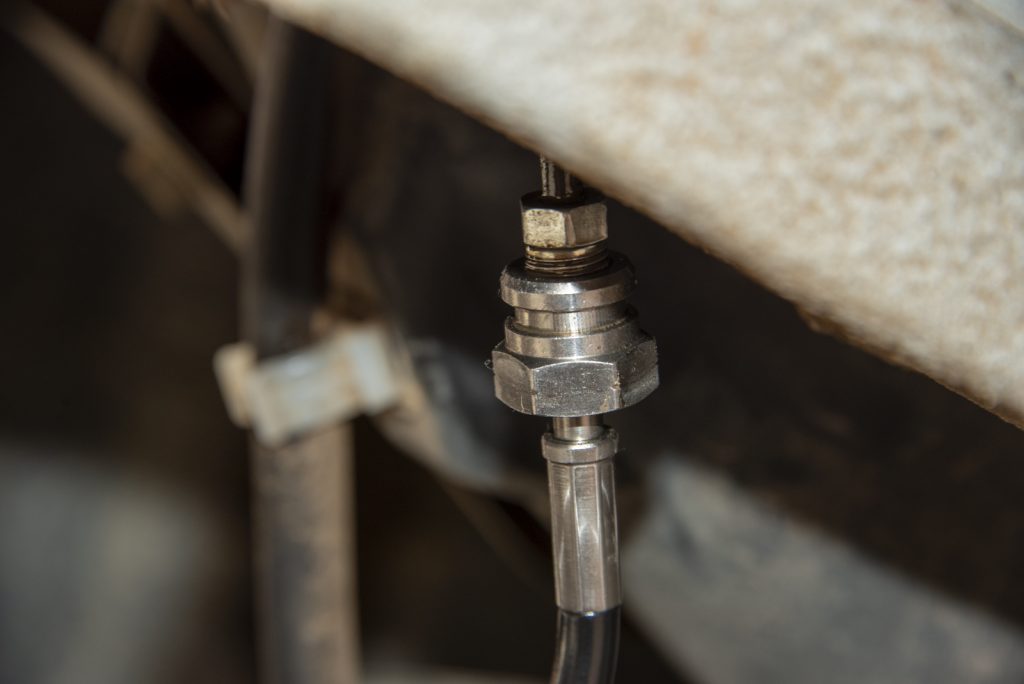
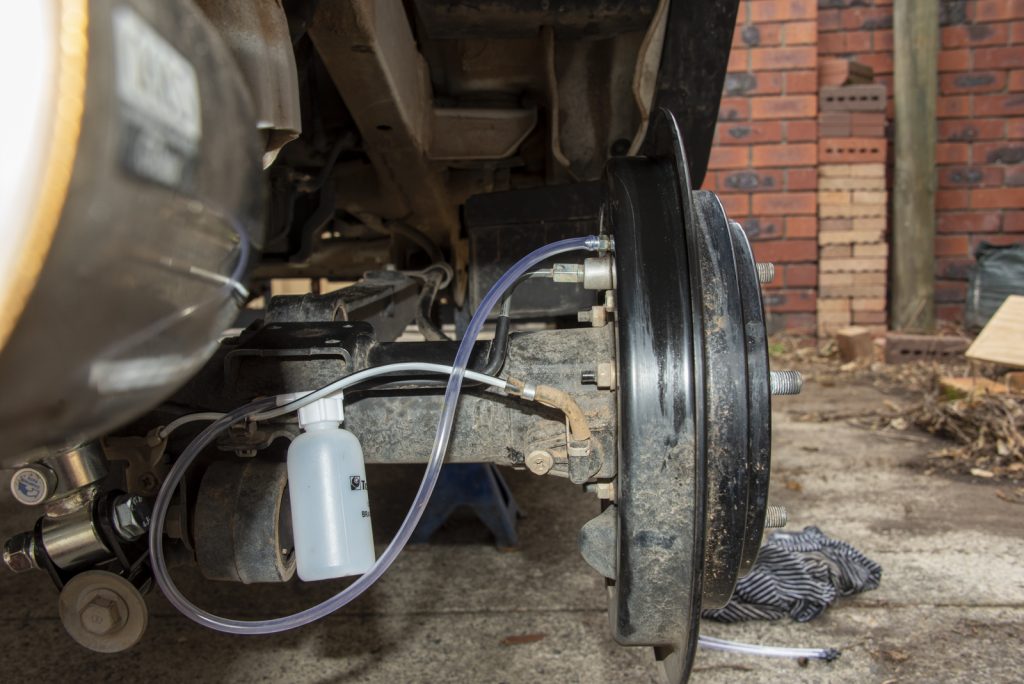
Now, lightly support the axle from underneath with a jack.
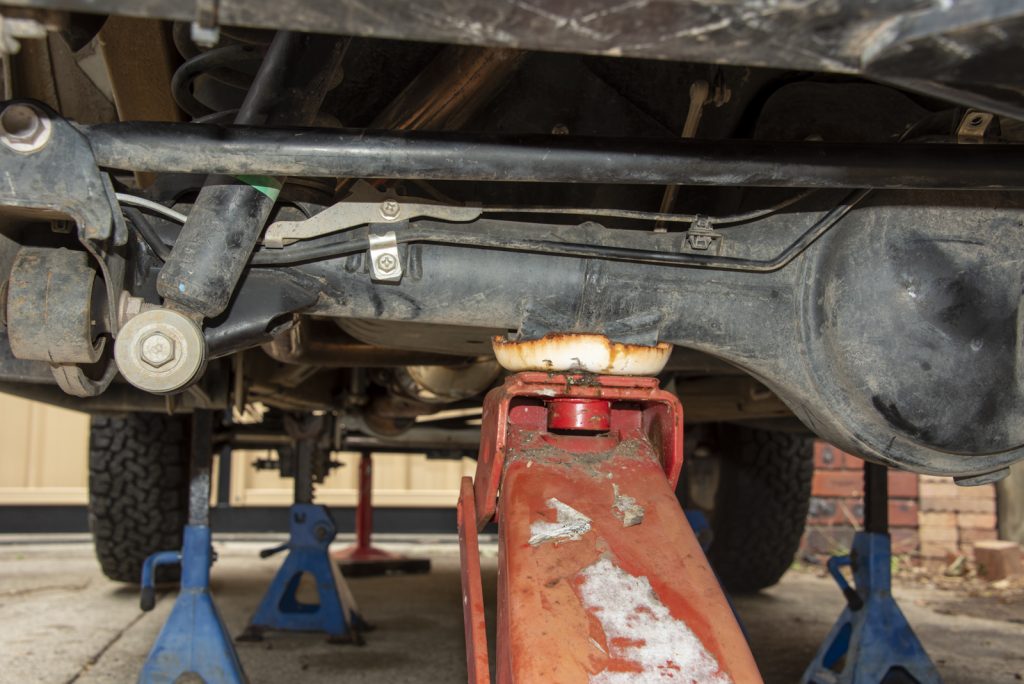
With the axle supported, you’re ready to undo the top and the bottom shock mount bolts and remove the shocks. Upper mount is a 17mm headed bolt which is quite hard to access except using a ratchet spanner on the right-hand side, the left hand side has enough room for a shallow depth socket on a ratchet. Lower bolt is 17mm x2, hold one end with a spanner and the other undo with a ratchet or a big breaker bar.
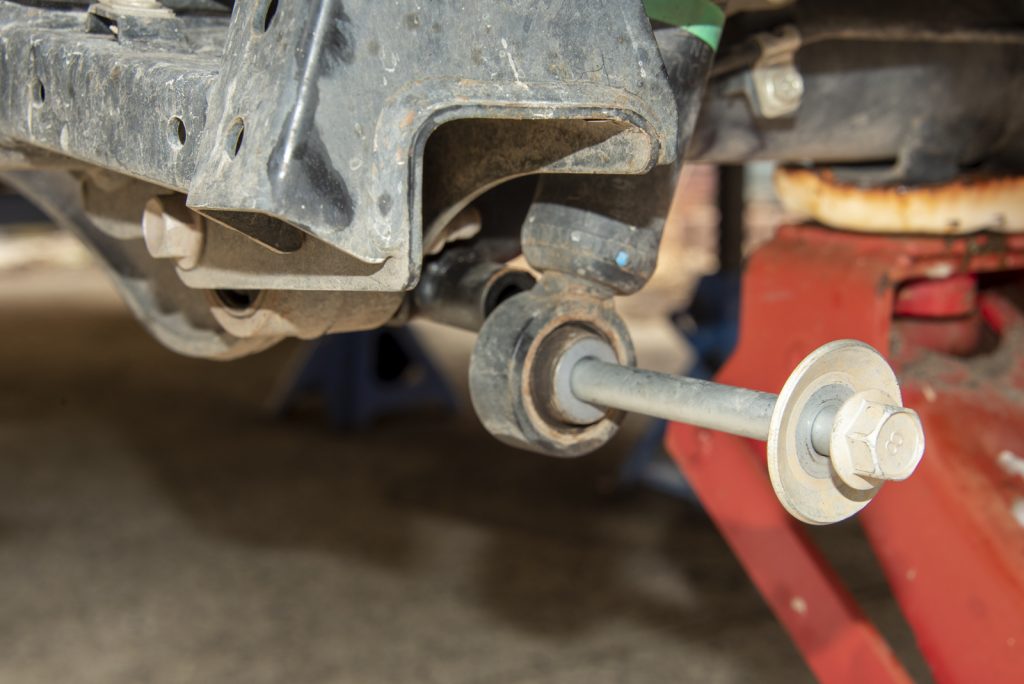

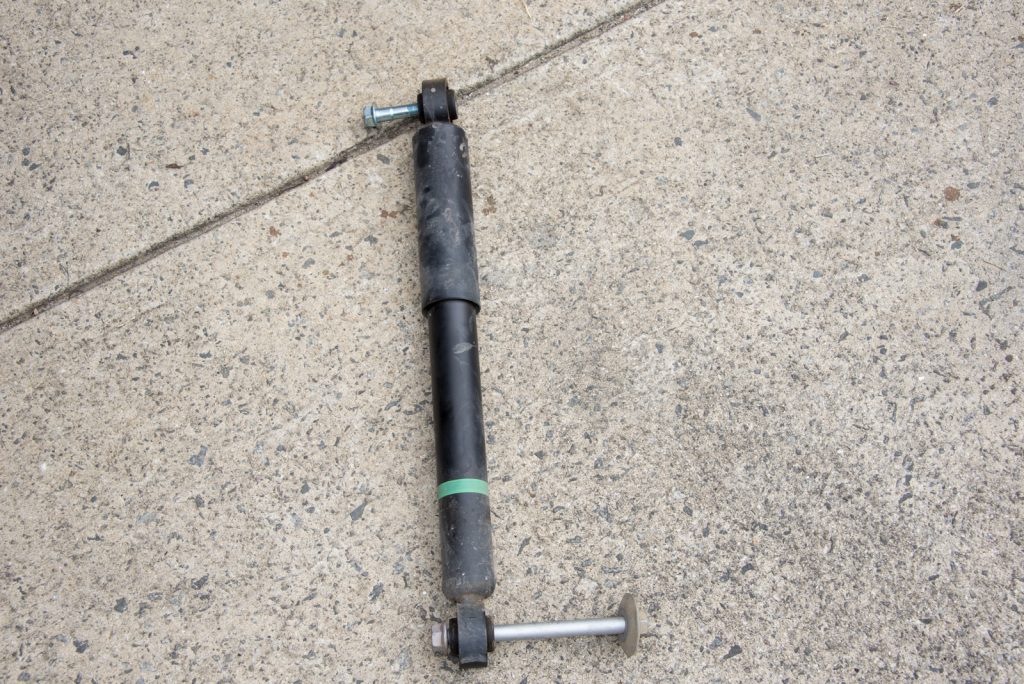
With the shock removed you can lower the jack and the springs will be released. If you struggle to get the new ones in, you can use the factory Jimny scissor jack between the radius arm and the chassis and it’ll push the axle that little bit lower.
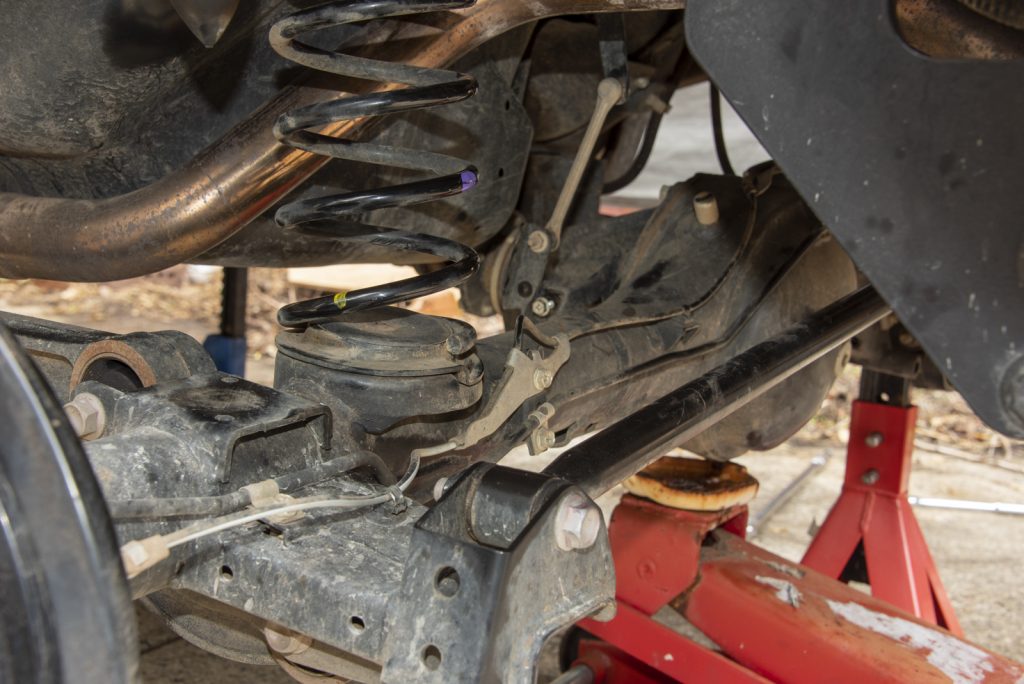
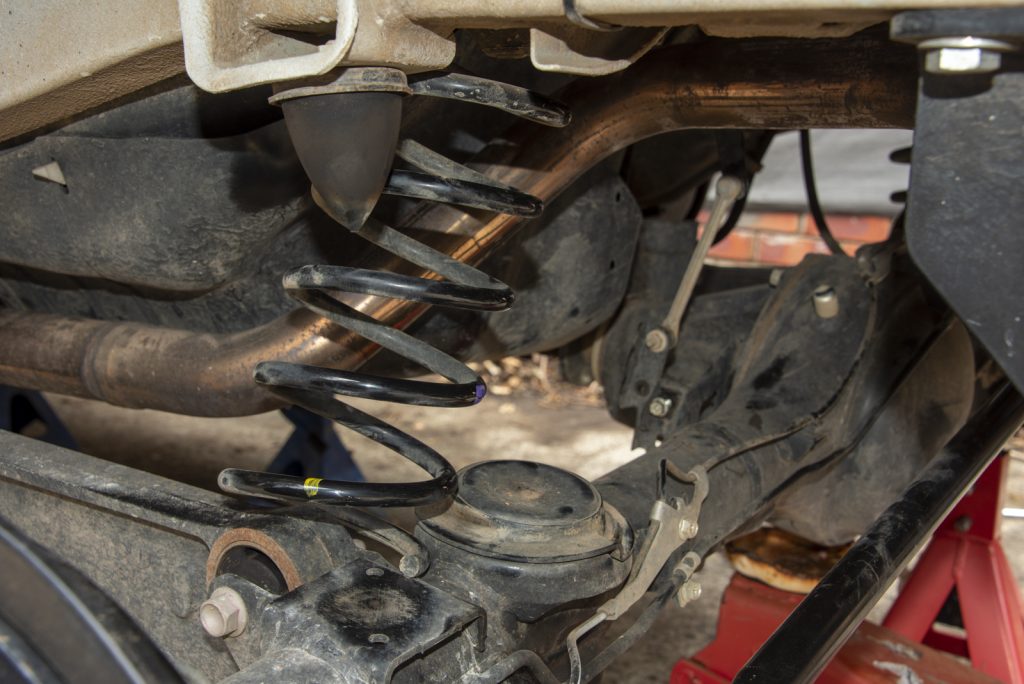
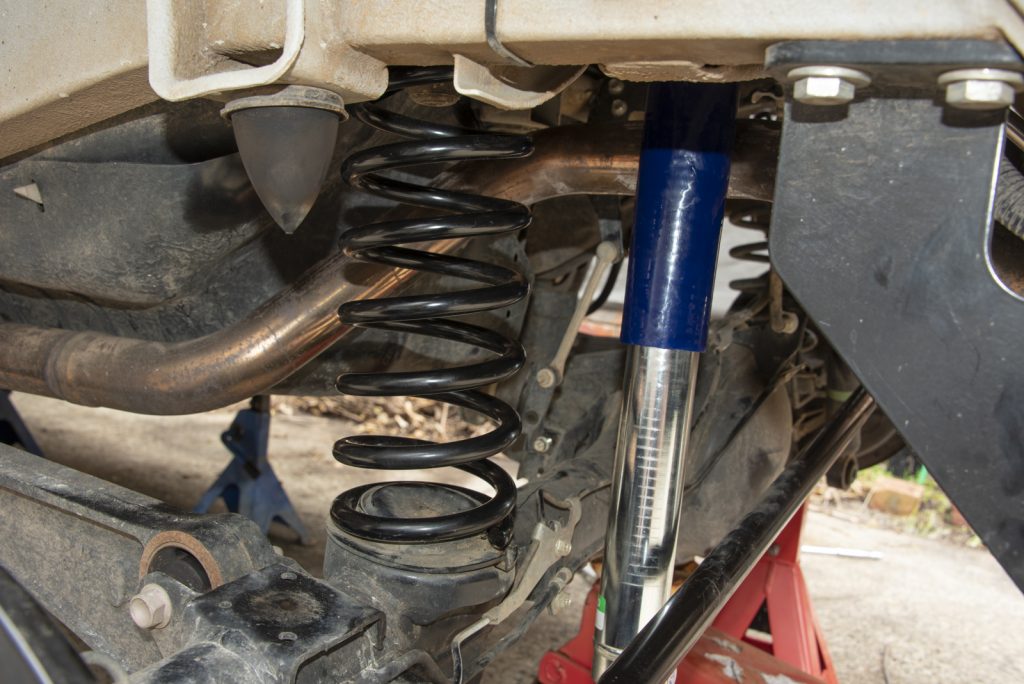
With the springs in, time to throw the shocks in. As I’ve mentioned, I’m running the Black Raptor premium kit so I have adjustable shocks & also I added bottom shock mount relocation brackets. These give a further 40mm of downtravel and reduce the strain on the shocks at full compression as they can pivot.
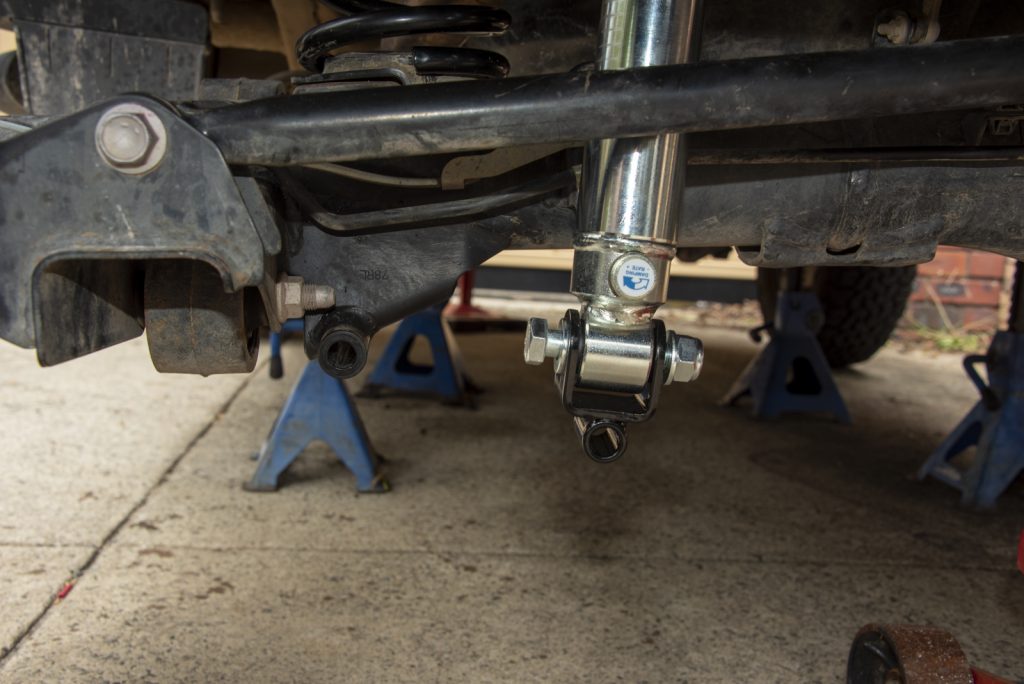
The relocation brackets turn the mount 90 degrees to the regular mount, so you have to mount them up using the supplied bolts and washers. These bolts are 19mm rather than the factory 17mm bolts.
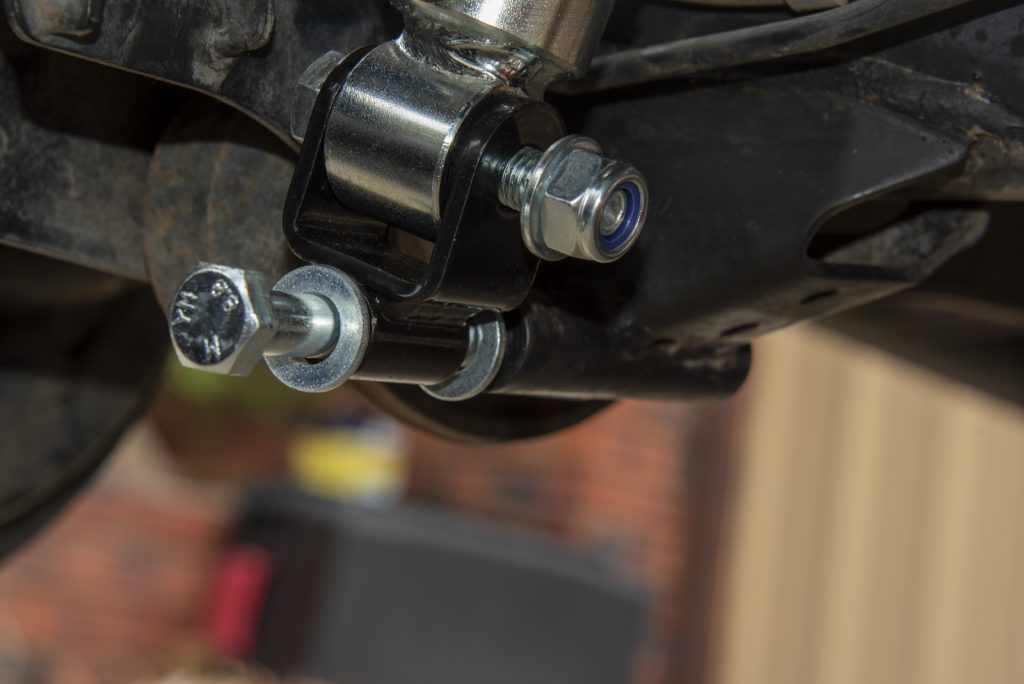
Just like the front, I tighten these up with the suspension taking the weight of the car just in case it makes a difference. Note the top shock bolt is reused, and this has threadlocker applied and is torqued to 70 Nm though getting a torque wrench in to do the right hand side is a challenge. Lower factory bolts are 45 Nm which should be upped to about 60 Nm with the fasteners supplied with the relocation brackets.
Rear panhard relocation bracket
One element to help with the handling characteristics of the Jimny is to consider the rear panhard relocation bracket. This lifts the axle end of the rear panhard rod up by about 40 mm. The main benefit of this is to raise the rear roll centre by half this amount, which counteracts the rear rolling so much with a lift installed. This in turn reduces roll oversteer which is something Jimnys have in spade, so it should help settle the on-road and fast road handling.
There are multiple options here, but I bought one from Taniguchi in Japan. The bracket is really good, and while it’s a tight fit it’s not hard to install.
You start by undoing the rear panhard rod bolt at the axle end.
The bracket then bolts on with 3 bolts: a larger one at the bottom, a smaller one at the top, and a bolt that goes through the original mount hole on the axle. This largest bolt has a crush tube in it; this tube is a tight fit to the bracket but some gentle taps with a plastic faced hammer got it in.
I would install the two side bolts before putting in the crush tube, however.
Tighten everything up to spec and you’re good. Note that you should tighten the panhard rod to the bracket itself with the car at normal ride height. This stops the bush getting a bit bound up. Torque setting for this bolt is 95 Nm.
Extended bump stops
This is only necessary if you have the rear shock relocation brackets. While they give you an extra 25 mm of down travel on the wheels, the rear bump stops are too short with the longer shocks meaning the shocks limit the travel at full bump instead of the bump stops. The solution here is to make up some spacers to take up the difference. There are commercial longer bump stops available but I figured I’d just whip up something.
To work out the shape I needed to cut out of some 10mm thick plate I had handy I used a dirty fingertip and a piece of paper to trace out the holes.
The three holes in the axle aren’t very accessible so I trimmed down some rivnuts so they weren’t too long and installed them after drilling out the holes to 9mm to take M6 rivnuts.
Fairly easy once you cut out and drill the plate. I used countersunk bolts and it looks pretty good for something done quickly. I will consider getting an aftermarket set of extended bump stops but this will work.
I fitted mine up with a little bit of rubber at the bottom to give me about 15mm of bump stop extension. This means I still have 10 mm extra travel upwards; it also means I won’t be punching the top of the shock absorbers through the floor.
Caster correction bushes
I haven’t fitted these yet, but I did buy offset bushes.
A longstanding debate is if you need them. The answer is… maybe. The more you lift the car the more the caster becomes negative, which makes for ‘quicker’ steering but that means it is nervous in a straight line/hard to keep straight. The thing is that no car is exactly the same and there’s about 2º of caster angle allowed by Suzuki anyway. Very rough rule of thumb for most 4wds (not just Jimnys) is about 1″ of lift = 1º of caster. So potentially you can lift your Jimny 2 inches and end up the same as someone standard. Equally well if yours was on the low end of the specifications and you lift it it’ll be incredibly nervous in a straight line.
The theory is simple though, you install offset bushes into the radius arms which twists the axle a bit changing the caster angle. For bigger lifts, you need replacement radius arms to get the appropriate level of caster angle.
If or when I get around to installing it, I’ll write up how to do it here. It can be done at home but you do need a press (maybe – I’m going to try a different method to show you how to do it at home, though I have a press anyway if that doesn’t work).
Steering damper
Unlike older Jimnys, JB74s come with a steering damper. I have bought an upgraded one, but I haven’t fitted it yet. If I do I’ll report findings and write up how to do it.
Wheel alignment stuff
The final thing to discuss is wheel alignment stuff. You don’t need a fancy wheel alignment after a lift is installed IF the car already was correctly aligned and you don’t screw with things you shouldn’t be touching when you do the lift.
The lift will change what is ‘straight ahead’ for the car. When you lift the car the steering box moves away from the wheel that it immediately steers and so you need to lengthen the adjustable drag link to get the wheel pointing straight ahead.
You don’t need to adjust the toe angle or anything, just the length of the drag link. This assumes, of course, you had correctly adjusted it.
It is possible to screw up this adjustment though and set it up wrong. The toe arm, which is the horizontal threaded rod connecting the two front wheels together at the back of the axle housing, needs to be set up to be sort of spun on or off equally at each end. If you adjust one end and then adjust the drag link you can end up with some weird alignment.
There’s basically nothing else adjustable on a Jimny, so don’t go believing you need a really expensive wheel alignment after doing your lift yourself.
My car has a slight twist to the right of the steering wheel which can be easily corrected just by the drag link, but it was already correctly aligned before I did the lift anyway.
Technical stuff
Standard versus lifted height
How much did I lift it? What is standard height, anyway? How much did your bullbar effect it before the lift?
Too many people measure lift just by the height the guards are or similar off the ground. This then fails to take into account
- any replacement wheels/tyres with a different diameter from standard;
- tyre pressure meaning the tyre is squished away from being perfectly round; and,
- the effect of tyre tread wear on the height of the tyre.
The correct way to measure a suspension or body lift is with respect to the middle of the axle. In lieu of being able to correctly measure this, what I do is make a small mark on the wheel cap in the approx middle of each wheel cap, and then I measure up from the ground to this point and then from this point to the highest point on the guard above the axle.
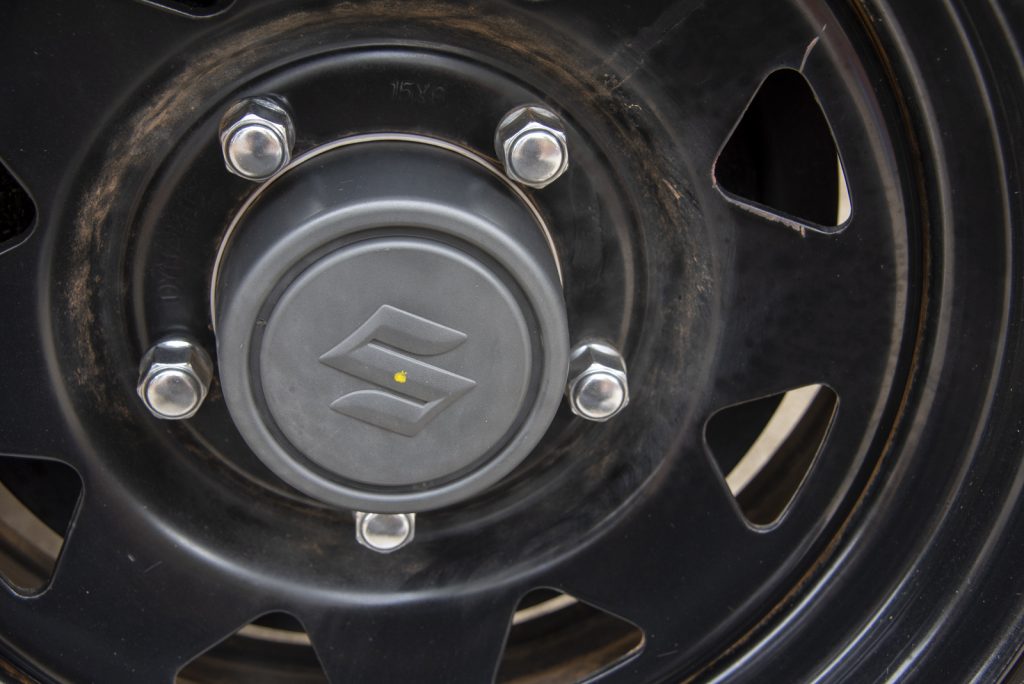
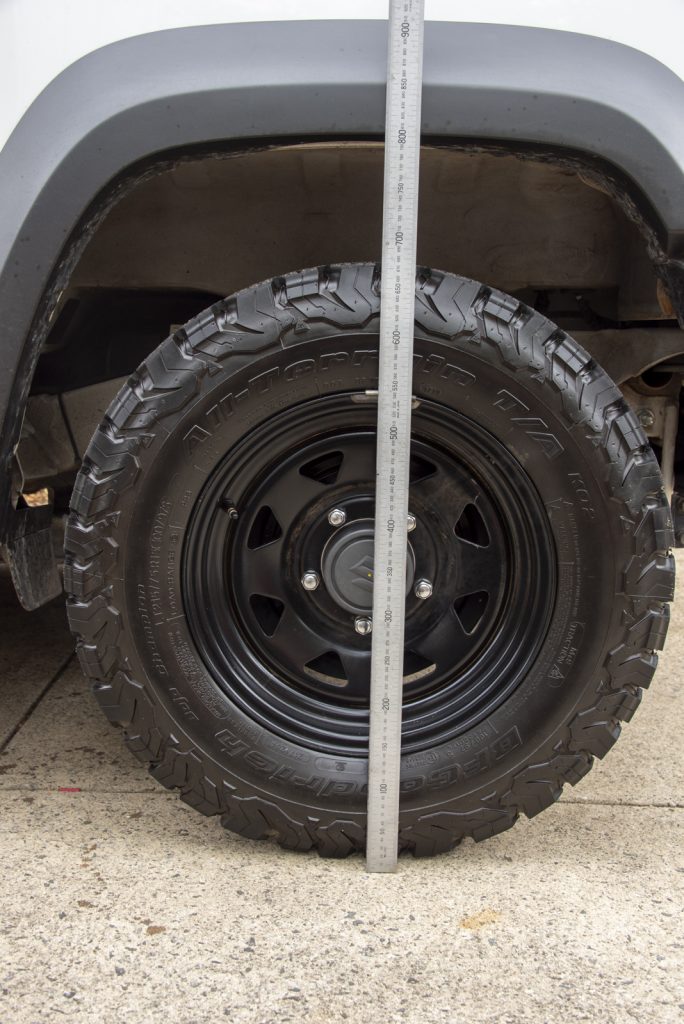
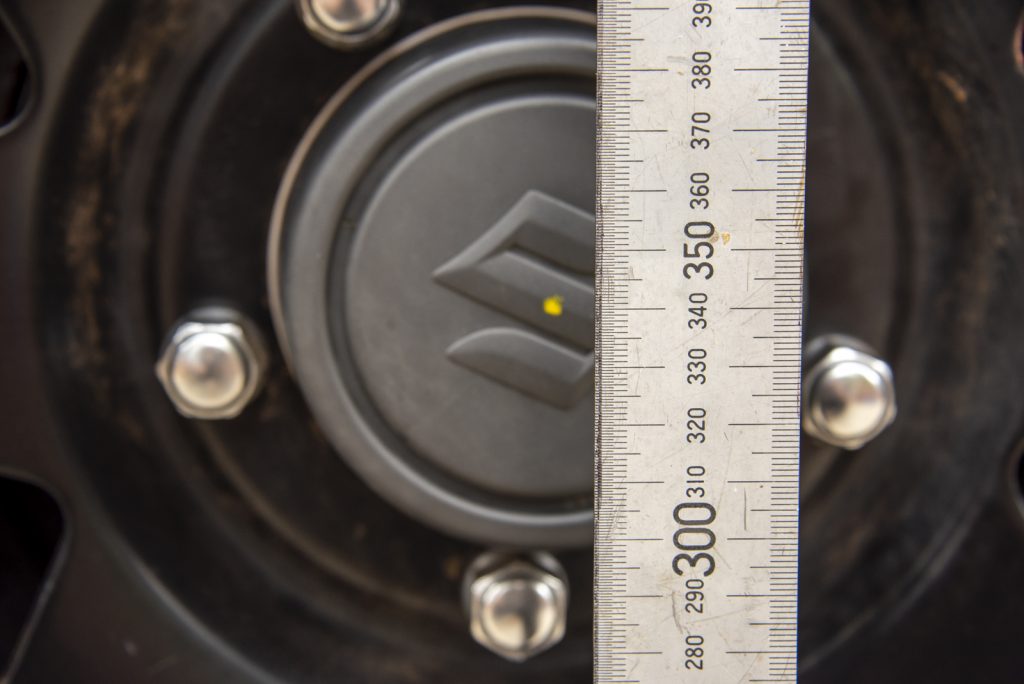
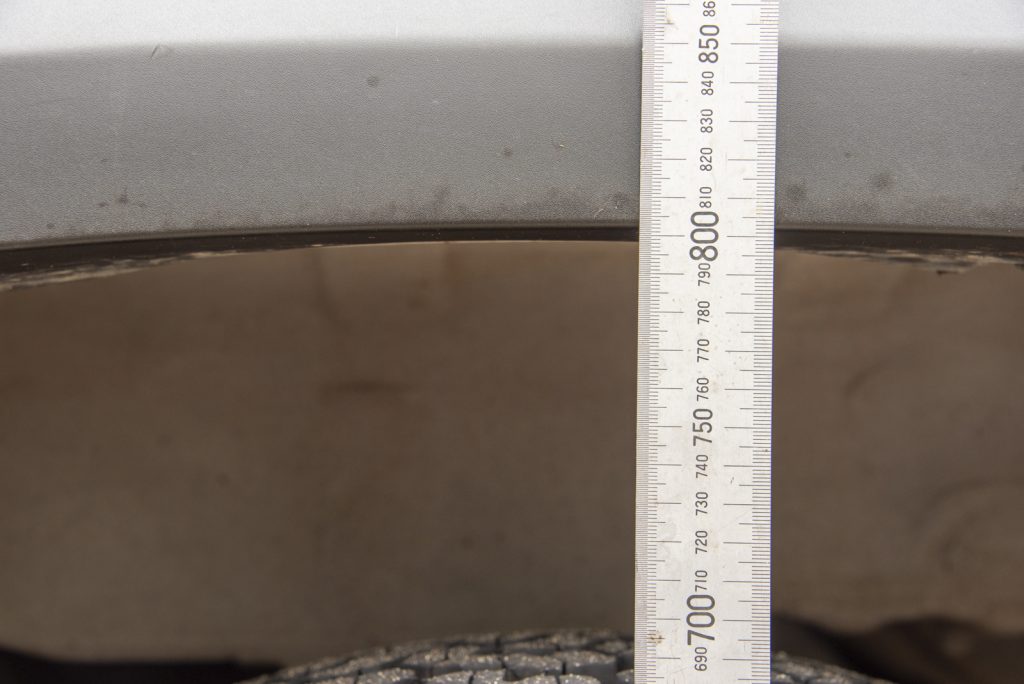
Doing the measurement this way means I can account for different tyre wear etc and also take into account any issue with where I’ve made the mark i.e. if it isn’t centred it won’t matter. The amount you lift is simply how much it changes between this mark and the top of the guard; if your measurements for wheels are different from the ground to the mark for that corner then that’s a sign the mark you have isn’t perfectly centred, but you can take that into account when you do the comparison.
Standard height, according to the vehicle standards information, is 464mm for the front from the centre of the axle, and 479mm at the rear.
Here’s a table with lift measured at various stages, along with standard but with bullbar and towbar added. I’ve added some columns to keep track of it to see if there’s any sag or any difference with adding accessories
| Corner | Standard height (measured centre of axle to guard opening) | Stock 23,000 km, bullbar, towbar, 10L fuel | Lifted: 23k km, barwork, 40L fuel |
|---|---|---|---|
| Front left | 464 mm | 452 mm (-12mm) | 497 mm (+33 specs, +45 from before fitting) |
| Front right | 464 mm | 442 mm (-22 mm) | 492 mm (+28 specs, +50 from before fitting) |
| Rear left | 479 mm | 470 mm (-9 mm) | 509 mm (+40 specs, +49 from before fitting) |
| Rear right | 479 mm | 461 mm (-18 mm) | 506 mm (+27 specs, +45 before fitting) |
The car is much more level and looks like it has about the right rake front to rear. You can also see how much more the drivers side has sagged through just driving with the stock figures, as opposed to the even distribution of the towbar and the bullbar. That said, it still is clearly a little lower on the drivers side which must be some other aspect to it – even down to an uneven driveway where I measured it.
The takeaway from this is the ARB bar does sag it by about 20ish mm and the towbar maybe takes about 8 mm off the ride height. I do plan on fitting spacers to the front once I add a winch, and it looks like maybe 30mm front spacers is a good call to offset the winch and bullbar correctly.
Brake line lengths
Having now had the chance to measure the stock lines, I can report the following lengths. Add length if you need for a lift, and I’ve included fitting information to make it easy to order up custom lines.
| Length | Fitting 1 | Fitting 2 | Support | |
| Front left and right | 550 mm (end of fitting to centre banjo) | M10x1.0 circlip female, straight | M10 banjo bolt, 20º angled | Large circlip fitting x1 |
| Rear long hose | 410 mm (end of fittings) | M10x1.0 circlip female, straight | M10x1.0 circlip female, straight | None |
| Rear short hose | 265 mm (end of fittings) | M10x1.0 circlip female, straight | M10x1.0 circlip female, straight | None |
In addition to the above, I had some back and forth with one of the Aus FB Jimny page members (Chris Dixon) who is doing a setup with minimal lift but long shocks for added droop (~115 mm longer than stock open length). To the lengths I provided Chris suggests the following:
- 90mm longer for the fronts
- 75mm for the rears
This is a lot longer than a typical 2″/50mm lift but that’s what happens with added axle droop!
Spring rates in JB74 lifts
This is a comparison of various lifts and their spring rates, based on either publicly available data or estimated via spring rate calculators. Some of this information has come from Royce Murphy who was kind enough to get some spring rates worked out.
I’ll try to add to this, but unfortunately not everyone publishes technical specifications and I’m not made of money to buy all of the lift kits to measure spring rates!
Front
| Lift | Free height | Spring rate | Source |
|---|---|---|---|
| Stock | 350 mm | 22 N/mm | Estimated from spring dimensions |
| OME – no bullbar (part #3189) | 370 mm | 21 N/mm | OME parts catalogue |
| OME – bullbar (part #3144) | 370 mm | 25.5 N/mm | OME parts catalogue |
| OME – bullbar & winch (part #3145) | 380 mm | 25.5 N/mm | OME parts catalogue |
| Tough Dog 40mm (part #TDC1000) | 375 mm | 24.9 N/mm | Estimated from spring dimensions |
| Ironman – variable load (part #SUZ009B) | 372 mm | 27 N/mm | Ironman parts catalogue |
| Ironman – constant load (part #SUZ009C) | 387 mm | 27 N/mm | Ironman parts catalogue |
| Black Raptor 2″ | Drivers: 390mm Passengers: 370mm | Drivers: 19.3 N/mm Passengers: 17.5 N/mm | Guessed from spring marking: 1100 = 110.0 in/lb = 19.3 N/mm 1000 = 100.0 in/lb = 17.5 N/mm |
| Taniguchi 60mm | Drivers: 419mm Passengers: 404 m | 18 N/mm | Taniguchi product listing |
| Showa Garage 50mm | Drivers: 405 mm Passengers: 388 mm | Drivers: 21.95 N/mm Passengers: 22.05 N/mm | Showa Garage product listing |
| Jaos Battle Z lift kit (40mm) | 19.8 N/mm | Jaos JB74 lift kit specification sheet | |
| Pedders TrakRider (part #280150) | 370 mm (loaded 283 mm) | 27.3 N/mm | Pedders product listing |
| Fulcrum Formula 4×4 50mm (KSFR-500) | Uses King springs that are unlisted: KSFR-500 | ||
| Dobinsons variable load 40 mm (C57-142) | Product catalogue | ||
| Dobinsons constant load (40-70 kg) 40 mm (C57-110) | Product catalogue |
Rear
| Lift | Free height | Spring rate | Source |
|---|---|---|---|
| Stock | Drivers: 315 mm Passengers: 300 mm | 22.2 N/mm | Estimated from spring dimensions |
| OME – medium load (part #3146) | Drivers: 350 mm Passengers: 340 mm | 22 N/mm | OME parts catalogue |
| Tough Dog 40mm (part #TDC1003) | Drivers: 340 mm Passengers: 330 mm | 30.9 N/mm | Estimated from spring dimensions |
| Ironman – variable load (part #SUZ010B) | Drivers: 340 mm Passengers: 320 mm | 30.9 N/mm | Ironman parts catalogue |
| Ironman – constant load (part #SUZ010C) | Drivers: 363 mm Passengers: 343 mm | 36 N/mm | Ironman parts catalogue |
| Black Raptor 2″ | 350mm | 26.3 N/mm | Guessed from spring marking: 1500 = 150.0 in/lb = 26.3 N/mm |
| Taniguchi 60mm | Drivers: 376.5 mm Passengers: 362 mm | 23 – 27 N/mm | Taniguchi product listing |
| Showa Garage 50mm | Drivers: 390 mm Passengers: 379 mm | Drivers: 19.6 N/mm Passengers: 19.1 N/mm | Showa Garage product listing |
| Jaos Battle Z lift kit (40mm) | 20.5 N/mm | Jaos JB74 lift kit specification sheet | |
| Pedders TrakRider 50 mm (part #s D/S 280194R, P/S 280194L) | Drivers: 340 mm Passengers: 320 mm | 29.8 N/mm | Pedders info sheet drivers side, passengers side. |
| Fulcrum Formula 4×4 50mm (KSRR-501) | Uses King springs that are unlisted: KSRR-501 | ||
| Dobinsons variable load (0-80 kg) 40 mm (C57-143) | Product catalogue | ||
| Dobinsons constant load (100-200 kg) 40 mm (C57-071) | Product catalogue |
Note that LHD vehicles for Ironman get part SUZ011B or C which are not staggered (at least according to the catalogue).
Shock lengths
Front
| Shock | Extended length | Compressed length | Travel | Source |
|---|---|---|---|---|
| Stock Suzuki | 415 mm | 280 mm | 135 mm | Measured |
| Bilstein B6 stock height (part #24-327329) | 401 mm | 266 mm | 135 mm | Bilstein specifications |
| Bilstein B6 raised height (part #) | 419 mm | 274 mm | 145 mm | Bilstein specifications |
| OME 40mm (part #60154) | 440 mm | 280 mm | 160 mm | Measured & OME catalogue |
| Tough Dog 40mm | 450 mm | 280 mm | 170 mm | Measured |
| Ironman (part #12759GR) | 440 mm | 277 mm | 163 mm | Ironman catalogue |
| Black Raptor 2″ | ||||
| Taniguchi 60 mm | 475 mm | 297 mm | 178 mm | Product listing |
| Showa Garage 50 mm | 460 mm | 290 mm | 170 mm | Product listing |
| CARBON RR2.0 Remote Reservoir shocks (RR20-JIMNY-19KIT) | 19″ = 483 mm | Product listing “Long Travel – Open lengths: 19 inch front & 20 inch rear” | ||
| Jaos Battle Z lift kit (40mm) | 156 mm | Jaos JB74 lift kit specification sheet | ||
| Pedders TrakRider 50 mm (131098) | No info on product listing but anticipate similar to many other 50mm lifts | |||
| Fulcrum Formula 4×4 50 mm (part 50033) | No info on product listing for dimensions | |||
| Dobinsons nitro-gas standard () | ||||
| Dobinsons nitro-gas 40 mm (GS57-617) | 438 mm | 283 mm | 155 mm | Product listing on 3rd party site: lengths might not be comparable, travel calculated |
| Dobinsons IMS 40 mm (IMS57-50617) | Product catalogue |
Rear
| Shock | Extended length | Compressed length | Travel | Source |
|---|---|---|---|---|
| Stock Suzuki | 450 mm | 305 mm | 145 mm | Measured |
| Bilstein B6 stock height (part #24-327336) | 454 mm | 298 mm | 156 mm | Bilstein specifications |
| Bilstein B6 raised height (part #24-321747) | 477 mm | 320 mm | 157 mm | Bilstein specifications |
| OME 40 mm (part #60155) | 515 mm | 325 mm | 190 mm | Measured & OME catalogue |
| Tough Dog 40 mm | 510 mm | 340 mm | 170 mm | Measured |
| Ironman (part #12760GR) | 495 mm | 310 mm | 185 mm | Ironman catalogue |
| Black Raptor 2″ | | | | |
| Taniguchi 60 mm | 525 mm | 331 mm | 194 mm | Product listing |
| Showa Garage 50 mm | 515 mm | 327 mm | 184 mm | Product listing |
| CARBON RR2.0 Remote Reservoir shocks (RR20-JIMNY-19KIT) | 20″ = 508 mm | | | Product listing “Long Travel – Open lengths: 19 inch front & 20 inch rear” |
| Jaos Battle Z lift kit (40mm) | 176 mm | Jaos JB74 lift kit specification sheet | ||
| Pedders TrakRider (131099) | No info on product listing | |||
| Fulcrum Formula 4×4 50mm (part 50034) | ||||
| Dobinsons nitro-gas standard length (GS57-616) | 460 mm | 310 mm | 150 mm | Product listing on 3rd party website: lengths might not be comparable to others; travel is consistent though |
| Dobinsons nitro-gas 40 mm (GS57-618) | 495 mm | 323 mm | 172 mm | Product listing on 3rd party website: lengths might not be comparable to others; travel is consistent though |
| Dobinsons IMS 40 mm (IMS57-50618) | 560 mm | 420 mm | 140 mm (?) | Product listing on 3rd party website: lengths look wrong so I’d |
